#as listed - alphabetically - in the title sequence
Text
well I think it’s clear that Conviction is not the show I thought it was lolololololol
#can we please just have one scene - just one - where alex cabot is not with mr. s2 discovery captain man#like i get it they're gonna fuck#he calls her alexandra#it's all very charming sexy passionate man of him#i guess#but ahhhhh she is your one established crossover property! why aren't you capitalizing on her??#and why! are there so! many! men!!!#this is all very 2000s show right from the hilariously time period title sequence#it told me what it was gonna be i didn't listen *crying emoji*#oh but hey i figured out why stephanie march isn't listed as starring in the imdb blurb - it's just literally the first three stars#as listed - alphabetically - in the title sequence#she doesn't even get better billing in her own show!!!#that also should have told me everything i needed to know#istg there are glimpses of a show that would have been really interesting! and they're all of alex-the-politician!!!#even if this hadn't been the alex cabot spinoff i thought it was starring stephanie march - a much better actor than many of these folks -#why not cast the personal questions the ada's have in prosecuting their cases against the bigger backdrop#of the politics that inform how they do their jobs#that is to say - the politics of bureau chief alexandra cabot#honestly#the da office politics we see in svu are legit compelling!!#but svu is also not written like a borderline cw show so :/#amy watches conviction (and it's a mistake)
8 notes
·
View notes
Note
hey. What the hell.
Just for that, here's a few more.
Small is bigger than big. Tall is shorter than short. You get "on" a horse but "in" a car. "No yeah" is yes, "yeah yeah" is no, "yeah no" is no, and "no no" is yes. There is no plural for the word "you". "Queue" is 80% silent letters. You say "unbelievable" but "intolerable".
Don't fucking test me.
The English language is a mess. Here's a list of some more oddities I just looked up.
“Rhythms” is the longest English word without the normal vowels, a, e, i, o, or u.
Excluding derivatives, there are only two words in English that end -shion and (though many words end in this sound). These are cushion and fashion.
“THEREIN” is a seven-letter word that contains thirteen words spelled using consecutive letters: the, he, her, er, here, I, there, ere, rein, re, in, therein, and herein.
There is only one common word in English that has five vowels in a row: queueing.
Soupspoons is the longest word that consists entirely of letters from the second half of alphabet.
“Almost” is the longest commonly used word in the English language with all the letters in alphabetical order.
The longest uncommon word whose letters are in alphabetical order is the eight-letter Aegilops (a grass genus).
The longest common single-word palindromes are deified, racecar, repaper, reviver, and rotator.
“One thousand” contains the letter A, but none of the words from one to nine hundred ninety-nine has an A.
“The sixth sick sheik’s sixth sheep’s sick” is said to be the toughest tongue twister in English.
Cwm (pronounced “koom”, defined as a steep-walled hollow on a hillside) is a rare case of a word used in English in which w is the nucleus vowel, as is crwth (pronounced “krooth”, a type of stringed instrument). Despite their origins in Welsh, they are accepted English words.
“Asthma” and “isthmi” are the only six-letter words that begin and end with a vowel and have no other vowels between.
The nine-word sequence I, in, sin, sing, sting, string, staring, starting (or starling), startling can be formed by successively adding one letter to the previous word.
“Underground” and “underfund” are the only words in the English language that begin and end with the letters “und.”
“Stewardesses” is the longest word that can be typed with only the left hand.
Antidisestablishmentarianism listed in the Oxford English Dictionary, was considered the longest English word for quite a long time, but today the medical term pneumonoultramicroscopicsilicovolcanoconiosis is usually considered to have the title, despite the fact that it was coined to provide an answer to the question ‘What is the longest English word?’.
“Dreamt” is the only English word that ends in the letters “mt”.
There are many words that feature all five regular vowels in alphabetical order, the commonest being abstemious, adventitious, facetious.
The superlatively long word honorificabilitudinitatibus (27 letters) alternates consonants and vowels.
“Fickleheaded” and “fiddledeedee” are the longest words consisting only of letters in the first half of the alphabet.
The two longest words with only one of the six vowels including y are the 15-letter defenselessness and respectlessness.
“Forty” is the only number which has its letters in alphabetical order. “One” is the only number with its letters in reverse alphabetical order.
Bookkeeper is the only word that has three consecutive doubled letters.
Despite the assertions of a well-known puzzle, modern English does not have three common words ending in -gry. Angry and hungry are the only ones.
“Ough” can be pronounced in eight different ways. The following sentence contains them all: “A rough-coated, dough-faced ploughman strode through the streets of Scarborough, coughing and hiccoughing thoughtfully.
Source
I hope you like being outsmarted, English Oddities Anon.
7 notes
·
View notes
Text
This is honestly going to suck but-
Okay, I don’t see enough people talking about this so- here we are. This will contain spoilers for the analog horror series, Guilty Tears Au of Sanders Sides. If you haven’t seen it or if any of the following triggers you, please skip: (I am listing the triggers from all the episodes just in case you want to watch it as well so some won’t make sense on a tumblr post, but just in case-) Disturbing Imagery, Loud Sounds, Body Horror, Blood, Gore, Death, Violence, Food (more like implied cannibalism, but ok-), Flashing Lights, Spiders, Ladybugs.
Now if any of that bugs you, I would say that this isn’t for you. This is just my personal opinion and analysis on this series! So let’s get started:
Episode 1: Teachers PowerPoint
So, we’re starting off with a very simple format; a PowerPoint presentation called “Dreams, a Manageable Analysis by Logan Sanders”.

Like omg Logan is so cute in this 🥺. He keeps talking about sleep and the benefits and downsides of it. But something is… off about it. The monitor keeps glitching out and skipping parts of the presentation. It skipped over the definition of Non-REM sleep, and it just is a bit strange. Then this happens:

And then it gets closer T-T. I kinda jumped when I saw it ngl- Then he gives us the definition of a nightmare. It kinda was normal at first but then-

Like wth-? This was honestly just weird to me me, cause he looked like a fucking demon- this isn’t even the weirdest part (and therefore not the most interesting).

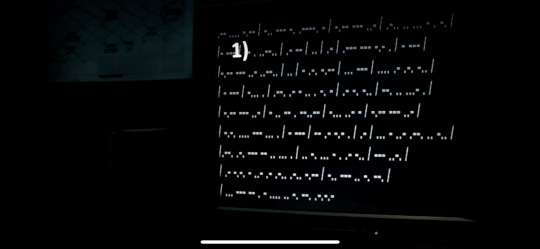
Now, the first one is obviously a reference to everything going on with the wedding arc and… other things. Missing Important Events? The callback. Loneliness. More so up to interpretation, or is it? I’ll come back to it later. Rejection? Again, back to it later. Confusing Emotions? All that Thomas has been dealing with for a WHILE. Broken promises, WTIT, anyone?
The second photo:
Morse Code Translated (not by me): WHY DON’T YOU LISTEN TO ME? AM I A JOKE TO YOU? I TRY SO HARD TO BE PATIENT AND GIVE YOU TIME, BUT YOU CHOSE TO MAKE A STUPID PROMISE INSTEAD OF ACTUALLY DOING SOMETHING
Wow.. well what I say about this, is that Logan is snapping at Thomas again, cause as we have seen, he tends to distract himself rather than actually solving his problems. Logan is trying to communicate with Thomas again and he. Won’t. Listen.
After that we got a number sequence:
19/20/15/16/9/7/14/15/18/9/14/7/18/5
If you line it up with the letters in the alphabet, you get “Stop Ignoring Re”. I thought I heard it wrong but I didn’t-. So there had to be a reason for it to say “Re” instead of “Me”, right? Right. I’ll be tying it together, I swear. Just bear with me here. I also find it interesting that a YELLOW GLOVED HAND turned off the monitor and put an out of order note on the screen (I mean it was pretty glitchy so I mean-).
(Also there is a sticky note on the bottom left corner that reads “DONT LOOK BEHIND THE CURTAIN” keep that in the back of your mind c:)
Episode 2: Forgotten Fairytale
So it starts with Janus opening a story book titled “The Young Prince”.
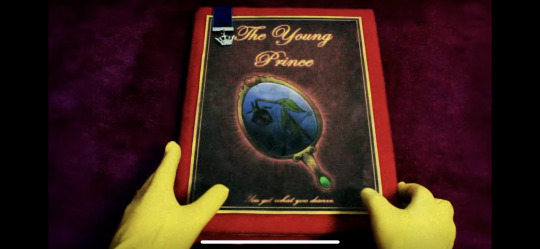
This is interesting- I see a little crown charm on the bookmark- Erin focus- okay so the cover already grabbed my attention. At first cause I thought of beauty and the beast and
H O L Y S H I T the parallels. We have a mirror with a green gem on the handle (I don’t think it’s important but I could be mistaken-). In it, a black wilting rose. Black roses itself mean death, while the wilting flower by itself means “Term used to supress desire when it would otherwise be impossible to fornicate.” Roman wanted to go to the callback (and ask out Nico), but it seemed just out of reach, so he ended up with choosing an option that goes against himself (Virgil helped him with Nico but still-).
To the actual story, it talks about how lonely Roman feels (Loneliness huh?) and that he wants to meet his true love. He searches and searches but can’t find them. One night, a witch pays a visit. He says that he wants to make a deal: he will give Roman his “one true love” in exchange for half of his kingdom. Roman didn’t want to risk it, and told him no.. the witch did not like that.
He cursed Roman, and his face had melted off. Overwhelmed by heartbreak, he locked himself in his tower. The people eventually forgot about him and he died alone, holding the wilted black rose..
And then Janus literally closes the book on that tale-. So Roman’s I feel is more metaphorical, he feels like his world is falling apart, trying to use love to distract him from the pain of his decision to go to the wedding, and the moment he was attacked, no one helped him.. (Janus I love you but you’re a bitch-)
Episode 3: Cookie Mistake
(Yes I’m sure it’s a pun off of Rookie Mistake, it’s Patton what did you expect?)
So this an actual person acting out Patton this time.

The puns 😭. But yeah, it’s a simple baking tutorial! And it’s a mime kinda thing, so we have dialogue on the screen. It seemed normal, but this is Guilty Tears.

He dumped the flour into the bowl and made a little bit of a mess- it’s baking what are you going to do about it? But Patton started shaking slightly saying “That wasn’t supposed to happen…” It’s okay I know you said you were feeling “crumby” but damn- it’s just flour.

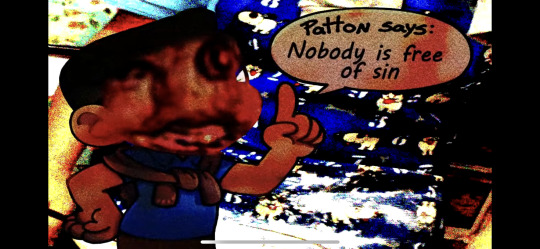
Ok then, laying it on thick. So Patton is freaking out over the little things and these little messages pop up. “Do you feel guilt consuming your every thought?” No I don’t think so- but this is maybe reference to POF, where he caused Thomas pain without realizing. The “Nobody is free of sin” seems like a twisted version of their new concept, “Not everything is black and white.” Patton is trying to distract himself from what happened and is only stressing himself out more.
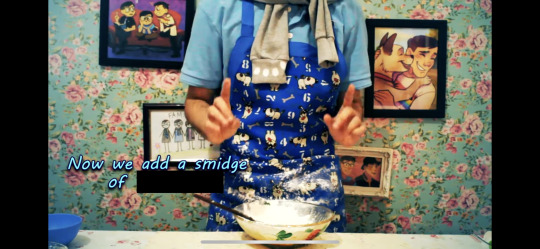

HOLY FUCK, PATTON- Okay. So there’s obviously SOMETHING going on. Why did he have blood in the first place? Why’d he think it was a good idea? Patton are you a cannibal now-?
This gave me an idea.. this could be both figurative or literal but, the blood is on his hands.. Let’s take a look at Virgil’s episode.
Episode 4: Wake Up Call
According to (assumedly) Thomas’ phone, it is 3:23 pm. April 23rd. Almost his birthday, hmm.

Holy shit- no✨ Dolls are creepy enough-. Anyway, it’s starts off by (I assume) Virgil asking Thomas:


So one answer is normal, one is more normal for Thomas and the other sounds more Anxiety related. He chooses to brush his teeth, but they fall out. In dreams, teeth falling out are associated with loss and important life changes. Thomas has been struggling to coming to terms with the fact that he isn’t a complete pure good, and his life has changed drastically. This series started from a silly blog and now it’s a series dealing with complex and controversial issues, while he’s struggling to show the world who he is.
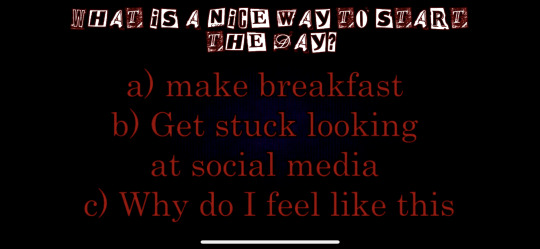

With the answers, they’re the same type. He chooses to make breakfast, but in the fridge with Virgil Doll, is a fucking skeleton/corpse and the fridge is all bloody. The “blood on his hands” thing might be more literal than we MAY have thought. Did Thomas kill someone? If so, who did he kill? I’ll get us there (hopefully-).


Okay- Hi Virgil- so, here I want to point out c. “I promise tomorrow I will change I will be a good person I will clean”. As soon as it had showed up on the screen, Virgil appeared. Thomas is making promises he can’t keep.
(“WHY DON’T YOU LISTEN TO ME? AM I A JOKE TO YOU? I TRY SO HARD TO BE PATIENT AND GIVE YOU TIME, BUT YOU CHOSE TO MAKE A STUPID PROMISE INSTEAD OF ACTUALLY DOING SOMETHING”)
Seems like Logan had another good point- Thomas keeps trying to say tomorrow this and tomorrow that, but Virgil knows. He wants Thomas to get up and be productive, but with Logan “out of service” you have anxiety based motivation. Virgil, being his anxiety, is also reminding him what he did.
At the end, Virgil doll is hanging by a thread (literally) and we see a gloved hand cut the thread. Setting Virgil free for now..
Episode 5: Important Reminder
Thomas is upstairs, and is going down to his living room to answer a knock at his door, and it is a WRECK. But worse than before. There’s blood on the walls and all that. He picks up “The Young Prince” something he apparently used to like during childhood, and finds this drawing between the pages:
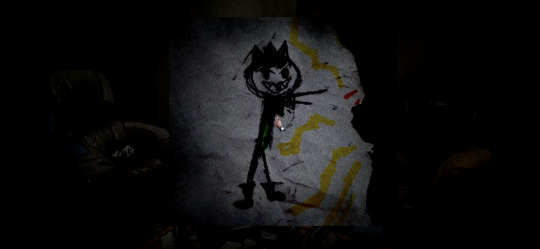
“Have you ever imagined killing your brother?”
“This is me electrifying my brother!”
Could this imply that Remus was actually the supposed witch? It was (possibly) the drawing mentioned in the Moving On episodes within the pages of a book where Princey died. This could be implying that ever since Remus appeared, Roman has been hurting. Maybe because he blames his dear twin for the murder?
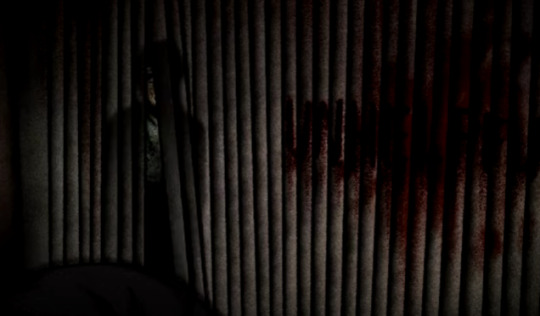
…
THIS IS WHY WE SAID DONT LOOK BEHIND THE CURTAIN-!?
Okay- I’m okay. If you can’t tell, the word “unhelpful” was written in blood, and there is some behind the curtain. I can’t tell who it is tho- Patton? Nightmare Nico?
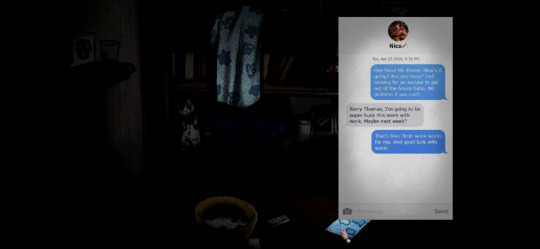
Speaking of Nico, ✨R E J E C T I O N✨
But really, Thomas is obviously having issues. He tried to get out the house, but Nico was busy that whole week. (Including his birthday 😢)
When he finally answered the door..:
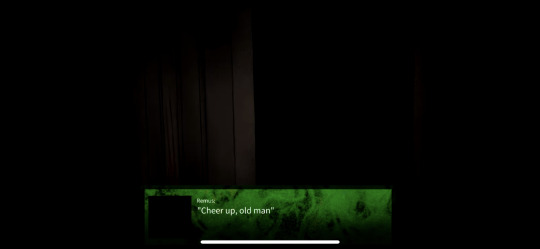
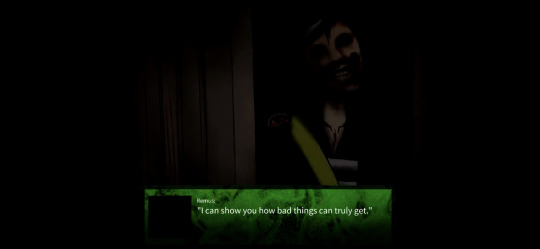
As we’ve seen in WTIT, Thomas is scared of getting older, so I think it’s interesting that Remus called him that. “I can show you how bad things can truly get” I think this is his twisted way of saying “Get over it, you didn’t do as much harm think you did.”
(“Stop Ignoring Re”)
But of course, Janus closes the door on him, shutting him away from Thomas.
Episode 6: Blinding Denial
>No no no.
>I’m fine, I’m alright.
>I’m just…
>I’m just tired.
>I’ll fix it tomorrow, okay?
>I promise.
Thomas have still not learned? 🤨

I feel when Janus leaves the baby crying, he’s not talking about a literal baby, but Thomas. Janus has been sheltering him from the sides trying to confront him (Turning off the PC, Closing the Book, Editing the Video + cleaning the blood, etc.) but has had enough of Thomas prolonging the inevitable.
“You’ve been walking in circles”
“You’re running away from yourself”
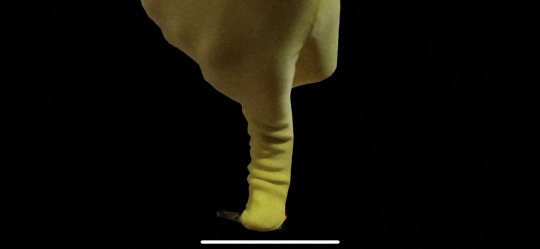
He squished the Ladybug. Whilst crushing the hope that good luck will suddenly make things better.
“It’s time to move on and forgive yourself”
~~~~~~~~~~~~~~~~~~~~~~~~~~~~~~~~~~~~~~~
Holy crap I did it. Well hopefully you enjoyed! See you later!
#thomas sanders#sanders sides#logan sanders#roman sanders#virgil sanders#patton sanders#janus sanders#remus sanders#guilty tears
24 notes
·
View notes
Text
Better File Rename Portable is an efficient and reliable software solution that will provide you with a wide range of file renaming options.
This tool can also be used directly from the context menu of Windows Explorer. Better File Rename Portable eliminates mistakes and guesswork, allowing you to view renaming options in real time, avoiding costly failures. Using this tool, you will also be able to batch process files, folders, and subfolders. You can even perform complex batch renaming tasks at the same time, saving precious time.
Better File Rename Portable is an ideal tool for photographers, both amateur and professional, that allows them to rename their photos and add shooting dates and times to their names. This information can be extracted from the photos.
Better File Rename Portable also allows you to organize your music collection, allowing you to extract and use the metadata that most music files contain.
Better File Rename Portable is a highly efficient application that allows you to delete, insert, replace or add text and characters and sequence number lists, change the case of sentence or title to upper / lower case, change file extensions and much more .
Characteristics:
replace file and folder extensions
make uppercase, lowercase, uppercase and lowercase, uppercase and lowercase
create space-saving alphabet sequences
truncate, remove vowels, reverse, transpose
Separate processing for file names and file extensions
Release year: 2021
Version: 6.25
System: Windows® XP / Vista / 7/8 / 8.1 / 10
Interface language: English
File size: 21.12 MB
Format: Rar
Execute as an administrator: There's no need
0 notes
Text
30 (Technically 34) Albums We Loved That Happened To Come Out in 2020
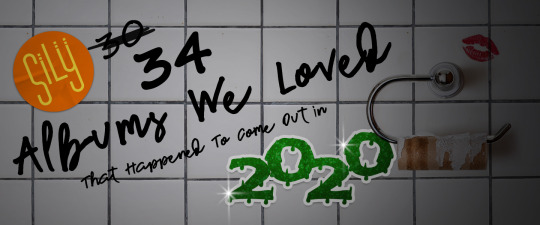
So much has already been said and written about this cursed past year, but a few good things came out of it, including the music. Album-wise, like many before it and many to come, it was an embarrassment of riches. But even with so much time on our hands to devour new tunes, it was often old favorites, songs of comfort or familiarity that garnered the heaviest rotation. For many artists, too, it was a year ripe for revisiting or reissues of old material, looking at existing songs with fresh and new perspectives. Simply put, with so much to listen to, new and old, the prospect of ranking a finite number of albums felt not only daunting, but frankly a bit stupid. Maybe we were late to the game, but 2020 taught us that music should and can be appreciated in multiple contexts, not limited to but including when it first came out and when it was heard again and again, even if years later. The records below--listed in alphabetical order--happened to be released in some form in 2020, whether never-before-heard or heard before but in a different format. And the only thing I know is that we’ll be listening to them in 2021 and beyond.
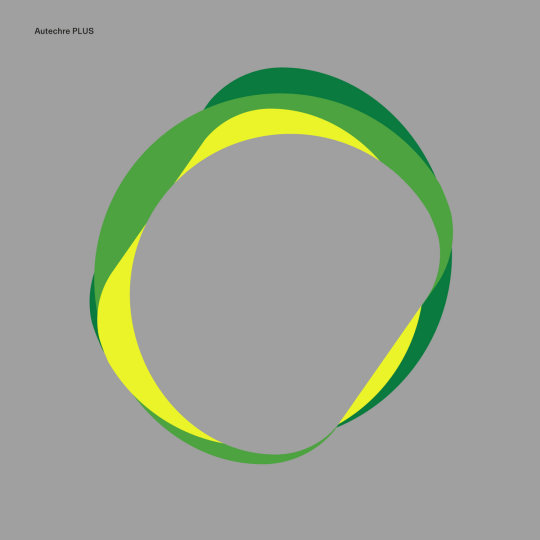
Autechre - SIGN & PLUS (Warp)
The legendary British electronic music duo surprise released SIGN a mere month and a half after its announcement and then PLUS 12 days later. The former was a beatific collection of soundscapes that belied the band’s usual harsh noise, while PLUS embraced that noise right back, drawing you in with the clattering chaotic burbles of opener “DekDre Scap B” and lurching forward. -Jordan Mainzer
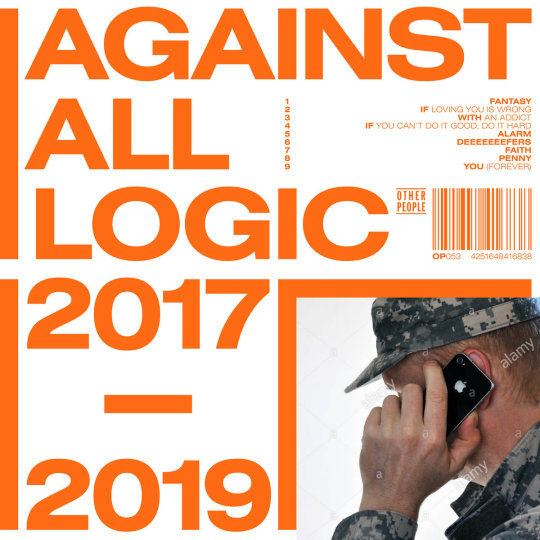
Against All Logic - 2017-2019 (Other People)
The perennially chill ambient house artist Nicolas Jaar had a busy 2020, as usual, releasing two albums under his name, Cenizas and Telas. But it was 2017-2019, the follow-up to the debut album from his Against All Logic moniker, that came first and throughout the year helped to illustrate Jaar’s penchant for combining inspired samples with club beats and tape hiss. Take the way the lovelorn vocals of “Fantasy” or soulful coos of “If Loving You Is Wrong” war skittering, scratchy percussion and cool arpeggios, respectively: Jaar is coming into his own as a masterful producer almost a decade after he released his first full-length. Oh, and bonus points for including none other than Lydia Lunch on a banger so blunt it would make Death Grips blush. - JM

Bartees Strange - Live Forever (Memory Music)
Like many, my introduction to Bartees Strange was through Say Goodbye to Pretty Boy, his EP of The National covers. Creativity and shifting perspectives shine through each song’s reimaging, like flipping the coarse, almost manic “Mr. November” into something softer, more meditative. It felt like a mere peek into what was to come on Live Forever. Bartees Strange is a world-builder. Each track on his debut unfolds and welcomes you to a wildly engaging tableau, a fully constructed vision. “Jealousy” opens with soft vocals and birdsong. “In a Cab” is the slick soundtrack to racing through a cityscape in the rain, seeing the blurred lights of the high-rises above as you pass by. “Kelly Rowland” warps wistful pop song feelings. “Flagey God” takes you into a dark, pulsing club while only a few songs later, “Fallen For You” wraps you in echoed vocals and romantic, raw acoustic guitar.
It’s an accomplishment to craft an album of individual songs that stand strongly on their own but still feel cohesive. 2020 wasn’t all bad. It gave us Live Forever, a declaration of an artist’s arrival. - Lauren Lederman

Charli XCX - how i’m feeling now (Atlantic)
Back in the spring, many of us wondered who would put out something great in 2020’s quarantine. It was hard to imagine that the intensity of a global pandemic would really allow for artists to embrace creativity. That thought carries the same eye-roll inducing feeling of “We’ll get some great punk music out of a Trump presidency,” but of course, Charli XCX delivered. Through live workshops with fans and longstanding collaborators, she delivered songs to dance alone to in your bubble. Charli embraces the unknown of the moment but clutches onto what’s familiar. Under the glitch-pop veneer of the album, she digs into the anxieties of not just this moment of time but of the bigger questions we all confront: trajectories of relationships with friends, romantic partners, ourselves. Album standouts “forever” and “i finally understand” embrace that feeling of both looking for control and accepting the lack of it. Charli is a master at balancing this. - LL

Christine and the Queens - La Vita Nuova (Because Music)
Named after a Latin text by Dante Alighieri about missing a woman who has died, Chris’ La Vita Nuova is not about mourning a death but instead about loneliness and isolation, post-relationship or otherwise. It doesn’t bang quite like her previous two albums, but it hits harder than ever.
Read our full review here.

Dogleg - Melee (Triple Crown)
Released on March 13th, right as the COVID-19 pandemic hit, Melee was supposed to be supported by three cancelled tours–SXSW, an opening slot for Microwave, and an opening slot for Joyce Manor–and an appearance at this year’s cancelled Pitchfork Music Festival. Listening to the songs on the record, you can only imagine how they translate: the jerky momentum of “Bueno”, build-up of “Prom Hell”, gang vocals of “Fox”, clear-vocal anthem of “Wrist”, and odd groove of “Ender”.
Read “Buckle Up, Motherfucker”, our interview with Dogleg.

Dua Lipa - Future Nostalgia & Dua Lipa/The Blessed Madonna: Club Future Nostalgia (Warner)
Where Dua Lipa’s much-anticipated second album Future Nostalgia succeeded was in its disco anthems and retro, club-ready beats, so who better to bring out the best of the record than The Blessed Madonna? The turntablist masterfully curates a mix of heavy hitters of the charts and the underground that not only offers an essential complement to Future Nostalgia but transcends it. Sending the tracks out to various producers and singers for features and then adding her own samples on top, she invites you to peel back the layers, enter a YouTube rabbit hole of sample searching as much as bopping along.
Read our full review here.
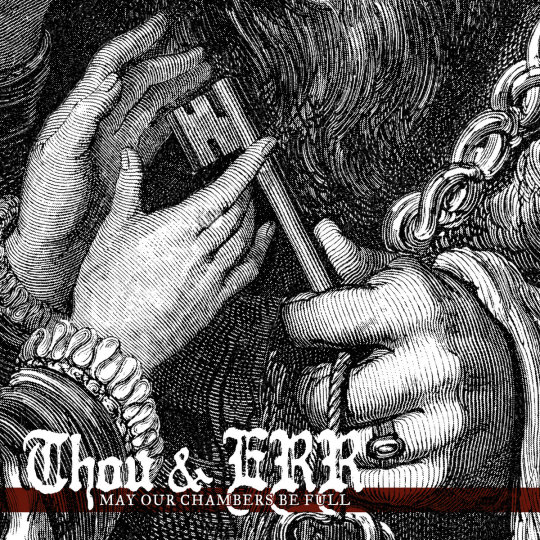
Emma Ruth Rundle & Thou - May Our Chambers Be Full (Sacred Bones)
Roadburn Festival has long been on my bucket list, and since the pandemic showed me how much live music can be taken away in a flash, when it’s safe again to travel and go to a festival, I may just pull the trigger and go--especially considering it’s the springboard for such fruitful and inspired collaborations as the one between Louisville singer-songwriter Emma Ruth Rundle and Baton Rouge sludge dwellers Thou. Rundle embraces the heavier opportunities on the follow-up to her incredible 2018 record On Dark Horses with the ever-flexible Thou backing her up vocally and instrumentally. Slow-burning opener “Killing Floor” offers a familiar introduction to fans of both--sort of what a Rundle/Thou song would sound like--before grunge chugger “Monolith” introduces huge, catchy riffs and “Out of Existence” a True Widow-esque dirge, newfound inspirations for both artists bringing the best out of each other. - JM
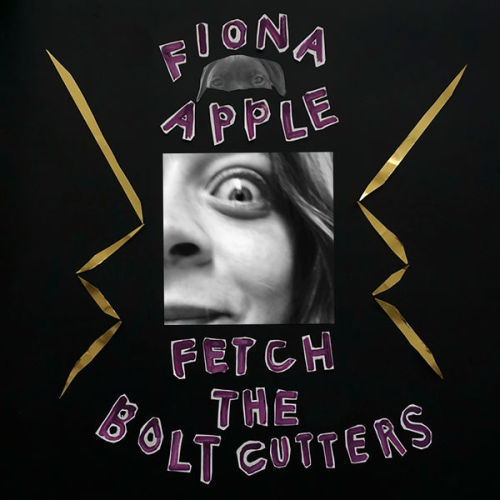
Fiona Apple - Fetch the Bolt Cutters (Epic)
What makes Fetch the Bolt Cutters stand out among Apple’s catalog and music in general is the clarity with which Apple seethes at those who have wronged her, whether ex-boyfriends or patriarchal oppressors, and looks to her relationships with other women for peace of mind.
Read our full review here.
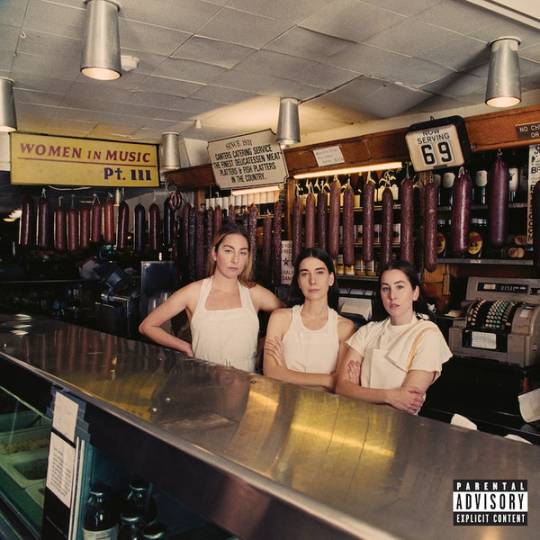
HAIM - Women in Music Pt. III (Columbia)
For HAIM, the title Women in Music Pt. III is suggestive that, more than their previous two records, their third centers around the experiences of being an all-female band in a historically white cis male-dominated scene, at least one that wouldn’t call catchy riffs written by a man “simple” or call attention to the faces a man makes while playing. What it doesn’t let on to is how deeply personal the record is, how, by unabashedly embracing genres and styles of music that they love, HAIM have made far and away their best album. Co-produced by the usual suspects, Danielle Haim, Ariel Rechtshaid, and ex-Vampire Weekender Rostam Batmanglij, it’s instrumentally and aesthetically dynamic and diverse, consistently earnest without devolving into cheese.
Read our full review here.
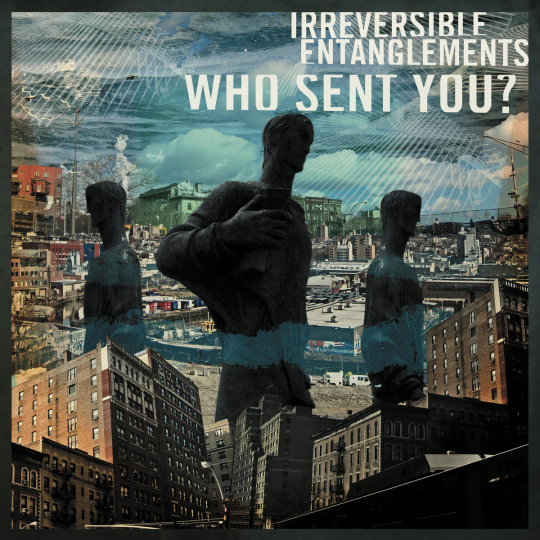
Irreversible Entanglements - Who Sent You? (International Anthem)
I’ve been captivated by Irreversible Entanglements ever since I first saw them at Pitchfork Music Festival 2018. The radical poetry of Camae Ayewa (aka Moor Mother) is the perfect front for a ramshackle mix of Luke Stewart’s spidery bass, Tcheser Holmes’ weighty drums, and a horn section that concocts tones that range from hopeful to desperate. At their best, Who Sent You? is a shining example of celebratory Afrofuturism and metaphysics that makes the urgency of Ayewa’s more concrete and political words all the more necessary. “No Más”, composed by Panamanian-born trumpeter Aquiles Navarro, is a declaration against imperialist oppression, while the stunning title track flips the switch like a Kara Walker painting, as Ayewa’s the one interrogating the police officer terrorizing her community. “Who sent you?” she repeats, never spiraling, grabbing a hold of the power and never letting go. - JM
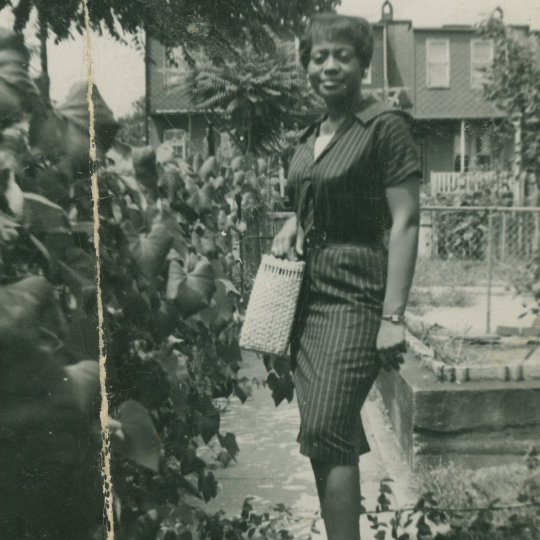
Jeff Parker - Suite for Max Brown (International Anthem/Nonesuch)
It’s Jeff Parker’s mom’s turn. After 2016′s The New Breed ended up being a tribute to the guitarist’s father, who passed away during the making of it, Parker decided to pay tribute to Maxine while she was still alive. Suite for Max Brown (Brown is his mother’s maiden name; Max is what people call her) is a genre-bending collection of tracks inspired by Parker’s DJing, juxtapositions of sequenced beats with improvisation that certainly sound like the brainchild of one individual. Indeed, Parker plays the majority of the instruments on it and engineered most of it at home or during his 2018 Headlands Center residency in Sausalito, CA; though all of the players and the vocalist (Jeff’s daughter Ruby Parker) on The New Breed show up, plus a couple trumpeters (piccolo player Rob Mazurek and Nate Walcott of Bright Eyes) and cellist Katinka Kleijn, Suite for Max Brown is a distinctly Jeff Parker record.
Read our preview of Jeff Parker & The New Breed’s set at Dorian’s last year.
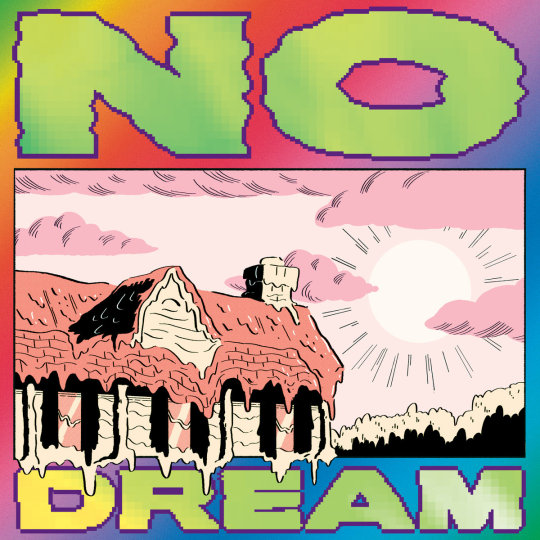
Jeff Rosenstock - NO DREAM (Polyvinyl)
Jeff Rosenstock throws us right into the spinning, manic energy of NO DREAM, his latest release from a seemingly endless well of music that never lacks urgency. It’s a reminder that though it’s been a strange year, the issues Rosenstock tackles here aren’t new. There’s no interest in making you feel comfortable here. On the album’s title track, Rosenstock sings, lulling you into a false sense of security, “They were separating families carelessly / Under the guise of protecting you and me.” But reality sets in, and the hazy guitars spin out as he spits, “It’s not a dream!” and, “Fuck violence!”
My image of Jeff Rosenstock in the year 2020 is masked up with “Black Lives Matter” scrawled across the fabric of his mask in Sharpie, performing album highlight “Scram!” on Late Night with Seth Meyers as high energy as ever. It felt like watching someone send out a beacon, both a distress signal and a call to arms. - LL

Jessie Ware - What’s Your Pleasure? (PMR/Friends Keep Secrets/Interscope)
I am not someone who goes to clubs. I don’t “go out dancing,” preferring to let loose in the privacy of my own home or a trusted friend’s house party. But Jessie Ware’s What’s Your Pleasure? makes me think I could embrace a night out like that, once the world opens up again, of course. The album is filled with syncopated disco beats that feel fresh and classic all at once. The abundant horns and strings on “Step Into My Life” are decadent, like light bouncing off sequins in a dark room. Ware’s voice is slinky and velvety one moment, windswept like her album cover the next. It’s songs like “Save a Kiss” that embrace both, allowing her to show off her range. - LL
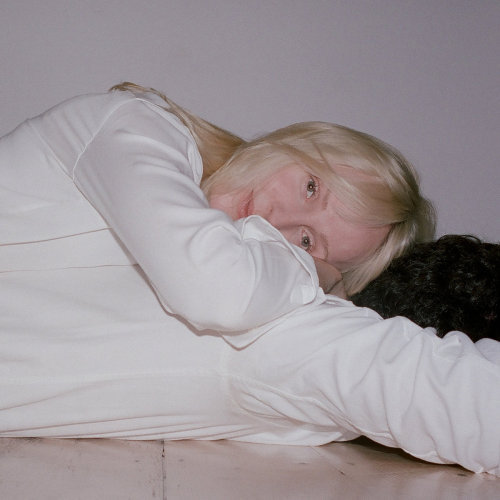
Laura Marling - Song for Our Daughter (Partisan)
With sparse production, mostly from her but with additions from Ethan Johns and Dom Monks, Marling foregoes the comparative maximalism of the Blake Mills-produced Semper Femina, her last proper full-length, and 2018′s LUMP collaboration. The songs aren’t simple, but they’re succinct, and every element, from Marling’s finger-picked guitars, the occasional slide guitar, and that unmistakably calm voice, sometimes alone and sometimes layered, fits. It’s her most universal set of songs yet, centering around the times when we’re apart from one another but reflecting on when we were together and when we might be together again, with no guarantees.
Read the rest of our review here.
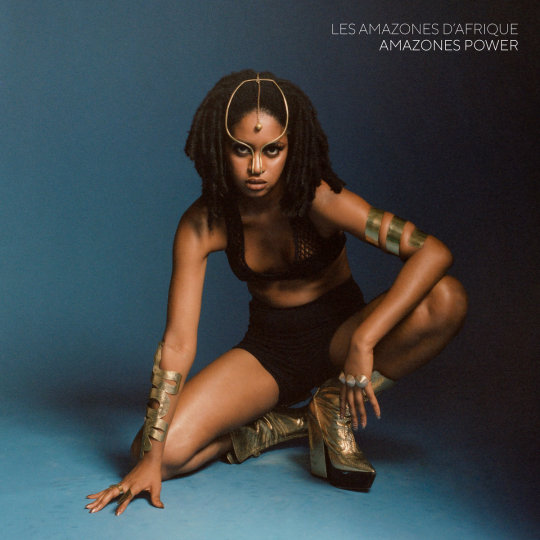
Les Amazones d’Afrique - Amazones Power (Real World Records)
The groovy pan-African collective expands upon their debut Republique Amazone and then some with Amazones Power, a tour-de-force statement of female empowerment in the face of oppression against women throughout the African diaspora. Indeed, the album is more than just songs boldly decrying FGM, though those demands ring heavily. Instead, the group goes further, delving into gender power structures in marriage on “Queens” and selectively finding strength in tradition on “Dreams”. And this time, they include men to stand alongside with them. “Together we must stand / Together we must end this,” sings Guinean musician/dancer/artist Niariu on opener “Heavy” in solidarity with features Douranne (Boy) Fall and Magueye Diouk (Jon Grace) of Paris band Nyoko Bokbae. But perhaps it’s her kiss-off on “Smile” that hits hardest: “I shut up for no one.” - JM

Lianne La Havas - Lianne La Havas (Nonesuch)
The British singer-songwriter’s much anticipated follow-up to 2015′s Blood was better than I could have ever imagined. A song cycle about life cycles--of nature, of lives, of a relationship--inspired by an actual breakup, Lianne La Havas is a contemporary neo soul masterpiece. Overview opener “Bittersweet” is an instant earworm, La Havas’ coo-turned-belt filling the space between classic and increasingly emotive slabs of piano and guitar. Funky, lovestruck strut “Read My Mind” is the soundtrack for the unbridled confidence of finding new love. Yes, the doubts begin to sow on the fingerpicked melancholy of “Green Papaya” and “Can’t Fight”, and where the album goes from a simple narrative perspective may be predictable: They break up, they don’t get back together, La Havas enjoys her independence. But the depth of the arrangements and assuredness of La Havas’ singing is a product of an artist starting to really show us what she can do. And how many people can pull off a Radiohead cover like that? - JM
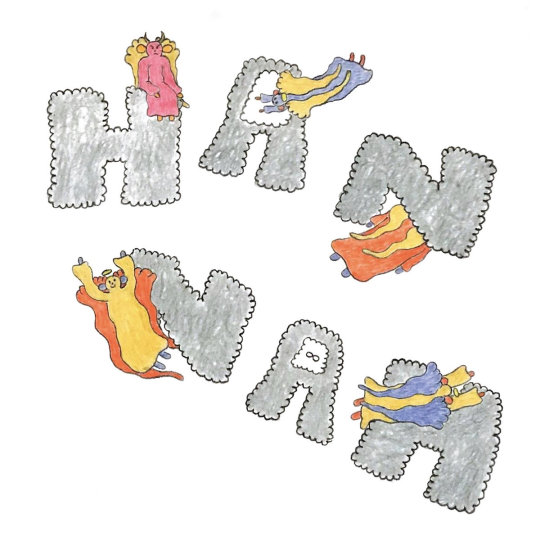
Lomelda - Hannah (Double Double Whammy)
What does it mean to title an album after yourself? Lomelda’s latest album is centered around discovering more about yourself while not always having the answers. Despite the lyrical content, the album is self-assured. Hannah Read’s voice feels as steady as ever as it navigates these twisting questions, like the way the world can shift after a kiss. She finds power in softness and reflection throughout the album, like when she explores the mantra-like words of “Wonder” or through a reminder to do no harm in “Hannah Sun”. In a year that allowed for perhaps more reflection than usual, Hannah makes space for the questions that arise out of figuring yourself out, of making sense of the messiness of it all, wrapped in warm guitar, balanced vocals, and steady drums. - LL

Moses Sumney - Grae (Jagjaguwar)
“Am I vital / If my heart is idle? / Am I doomed?” Moses Sumney famously sang on his stunning 2017 debut Aromanticism, an album that saw him developing his acceptance of being alone. grae, his two-part 2nd full-length, and his first since officially moving from L.A. to the Appalachian Mountains of Asheville, North Carolina, doubles down on themes of heartbreak, but instead of being sure in his seclusion, he embraces the unknown. The album teeters between interludes of platitudes about isolation and ruminations on failed human connection, and maximally arranged clutches of uncertainty. “When my mind’s clouded and filled with doubt / That’s when I feel the most alive,” Sumney coos over horns and piano on slinky soul song “Cut Me”; it’s an effective mantra for the album.
Read the rest of our review here.

Norah Jones - Pick Me Up Off The Floor (Blue Note)
At the time we previewed Norah Jones’ 7th studio album, she had only released a few tracks from it. Turns out the rest was just as powerful. From the blues stomp of “Flame Twin” to the rolling piano stylings of “Hurts to Be Alone”, Pick Me Up Off The Floor is an album full of jazzy orchestrations and soul and gospel-indebted arrangements, Jones’ silky, yearning voice tying together the simple, yet lush and deep instrumentation. And that other Tweedy feature, that closes the album? It’s a heartbreaking portrait of loneliness, one of many on a record that still manages to celebrate being alive all the while. - JM

Phoebe Bridgers - Punisher (Dead Oceans)
Phoebe Bridgers is a master of details. Her lyrics shine when they get specific. They range from the mundane to morbid: A superfan’s ghost-like wandering under a drugstore’s fluorescent lights, a skinhead likely buried under a blooming garden, reckoning with the you in “Moon Song”’s lines, “You are sick, and you’re married / And you might be dying.” Bridgers has always been able to set a scene meticulously, and Punisher arrived with 11 songs that expanded that skill, both lyrically and musically, with her dark humor intact and a fuller sound that includes her boygenuis collaborators’ harmonies. - LL
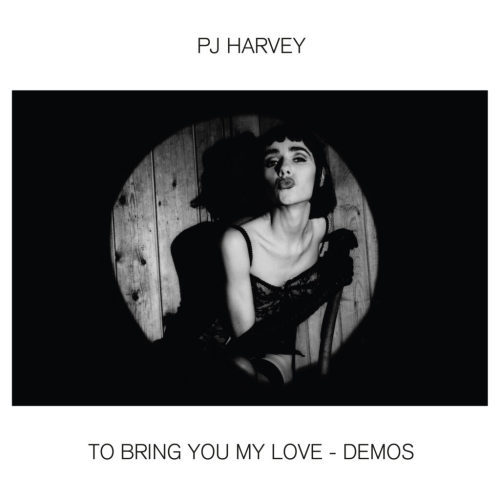
PJ Harvey - To Bring You My Love: The Demos & Dry - The Demos (Island)
Yes, revisiting Dry’s demos as a separate entity is still worthwhile. Harvey’s powerhouse vocal performance carries the acoustic strummed “Oh My Lover”, while the comparatively minimal arrangement of “Victory” highlights bluesy riffing, call-and-response harmonies, and layered guitar and vocals. The singles, the slinky and sharp “Dress” and propulsive anthem “Sheela-Na-Gig”, hold up to their ultimate studio versions, too. But it’s the To Bring You My Love material that provides novelty because it’s never been released and more so because it encompasses the greatest aesthetic contrast from the album. From the warbling hues and guitar lines of the title track to the tremolo haze of “Teclo” to the crisp snares of “Working With The Man”, the demos show a continuity and level of cohesiveness with the diversity of Dry and Rid of Me not shown on the studio version of Harvey’s more accessible commercial breakout. (Predictably, the album’s most well-known song, “Down by the Water”, is the closest to its eventual version.) “Long Snake Moan” is simultaneously more spacious and more noisy, its garage blues a total contrast to the lurking “I Think I’m A Mother” and swaying shanty “Send His Love To Me”. And “The Dancer” fully embraces its flamenco influences, hand claps and all.
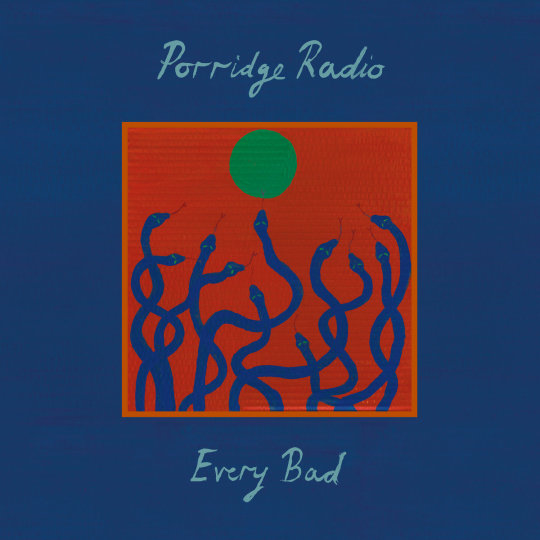
Porridge Radio - Every Bad (Secretly Canadian)
Is there a better opening line than “I’m bored to death, let’s argue”? That kind of duality is found across all of Every Bad as it grapples with the frustrations and anxiety of trying to figure it all out, whatever that might mean for you. “Maybe I was born confused, but I’m not,” vocalist Dana Margolin repeats throughout the opening track, roping in listeners with the dizzying feeling of trying to make sense of yourself. The band’s guitar and synth sound coupled with Margolin’s howl makes for a dance party filled with dread, rendering Margolin’s already strong, repetitive lyrics even more spiraling. And yet, by the time we get to “Lilacs”, a glimmer of something else shines through as the music gets more manic and Margolin’s voice begins to soar: “I don’t want to get bitter / I want us to get better / I want us to be kinder / To ourselves and to each other.” - LL
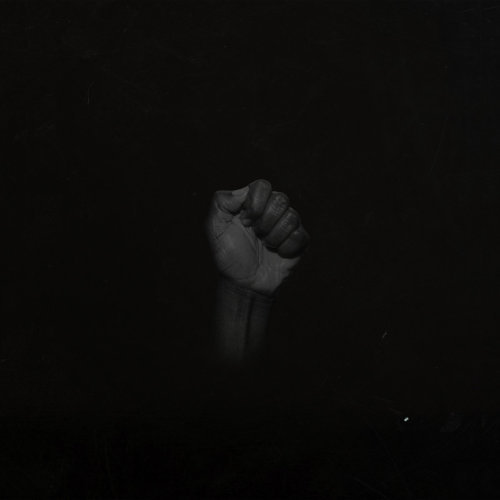
Sault - Untitled (Rise) & Untitled (Black Is) (Forever Living Originals)
Yes, Black Is still pulls plenty of devastating punches. “Eternal Life”, a segue from the gospel boost of “US”, juxtaposes a deliberate drum beat with zooming synths, both ascending like a chorus of angels, as they sing, “I see sadness in your eye / ‘Cause I know you don’t wanna die,” presenting the oppression of Black life at the hands of white supremacy in inarguable terms. Ultimately, though, it’s the anthemic nature of the songs, resistant of platitudes, that shines through. “Nobody cared / This generation cares,” says Laurette Josiah on “This Generation”. Whether she’s talking about young people in general or the latest generation of young Black leaders, the sentiment is reflected on songs like “Black”, wherein over dynamic, sinewy instrumentation, the singers alternate between encouragement, support, and love of the self and others.
Read our full review here.

Shamir - Shamir (self-released)
Shamir’s voice is a bright beacon in a sea of conventional singers. Shamir captures the effervescence of pop music and weaves it together with elements of country, alt rock, and diary confessional lyrics all supported by the emotion and range of his vocals. There’s something for everyone across the album’s 11 shimmering tracks. Lead single and opener “On My Own” feels like a declaration of self and self-sufficiency, an anthem of a breakup song. The almost pop-punk bounce of “Pretty When I’m Sad”, paired perfectly with lines like the angst-ridden, “Let’s fuck around inside each other’s heads,” feels impossible to not bop along to. The twang of “Other Side” would put a country crooner to shame. That’s the power of Shamir. His voice has the ability to smoothly convey joy, resilience, and humor. He uses elements of several genres, not just the dance-pop of his debut, to build a unique album that gives listeners so much to sift through and, of course, dance to. - LL
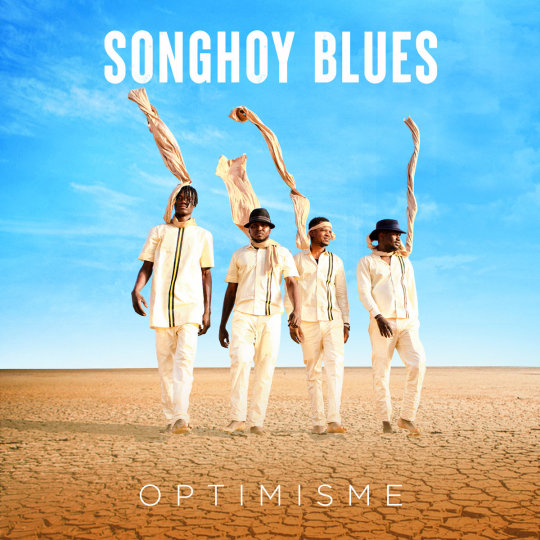
Songhoy Blues - Optimisme (Fat Possum)
If Songhoy Blues’ second album Resistance lacked “the grit of its predecessor,” it’s clear from the hard rock stomp of the opening track of Malian band’s third album Optimisme that they rediscovered their mojo. More importantly, they couple this maximal brashness with tributes to those who make their world a better place: fighters for freedom, women, the young. It’s perhaps the first Songhoy Blues record to truly combine the celebratory nature of their desert blues with a balanced mixture of idealism and vigor. - JM
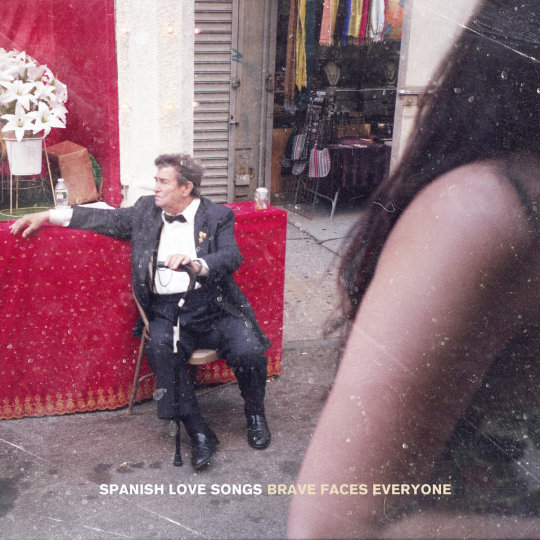
Spanish Love Songs - Brave Faces Everyone (Pure Noise)
How can you find hope in hopelessness, or optimism when every news story points to cruelty? Is it naïve to keep searching for light in the dark? I don’t think so, and I don’t think Spanish Love Songs does, either. I’d like to think we both believe that’s not naivety, but power. It’s the embers you need to really ignite a flame. After all, this is the band with a song titled “Optimism (As a Radical Life Choice)”. It’s a band whose crunching guitars and earnestness insist that despite death and depression and addiction, the instinct to survive shines brightly above all. That relentless hope resurfaces across Brave Faces Everyone’s 10 tracks even as it works through the bleakness of everyday life. - LL

Tashi Dorji - Stateless (Drag City)
The magnum opus from the Asheville-based picker is a group of evocatively titled, disorderly songs about the desolate hellscape of America for outsiders and immigrants. Enigmatic in its nature, not exactly narrative, Stateless combines Dorji’s urgent strumming with moody motifs, captured beautifully in a studio setting for maximum emotional wallop. - JM

Touche Amore - Lament (Epitaph)
Is this what an almost uplifting Touche Amore album sounds like? It’s cathartic in a newer way for the band, especially after the beautifully rendered grief of Stage Four. Lament loses none of the band’s aggression or urgency. “Come Heroine” thrusts listeners into that urgency and introduces a moment of warmth, Jeremy Bolm’s vocals still rasping and insistent: “You brought me in / You took to me / And reversed the atrophy.” The bounciness of “Reminders” may seem close to optimism, but a sharper look at the lyrics uncovers more than blindly looking to the things that bring joy. “I’ll Be Your Host” is reflective, a few years removed from Touche Amore’s previous album and the immediacy of loss, self-aware and growing, but still raw. The album closer, “A Forecast”, takes a turn, a lone voice and piano acting as a confessional before giving way to thrashing guitars and the realization that growth and reckoning with trauma doesn’t mean minimizing it. It means learning to keep moving forward and to stop for help when you may need it. - LL

Waxahatchee - Saint Cloud (Merge)
The best album yet from Katie Crutchfield is inspired by positive personal change (getting sober, dealing with codependency issues, her blossoming love with singer-songwriter Kevin Morby) and reflections on family and friends. Named after the suburb of Orlando where her father’s from, Saint Cloud is a genre-hopping collection of stories and feelings that doesn’t necessarily follow any semblance of narrative. On opener “Oxbow” and country-tinged ditty “Can’t Do Much”, Crutchfield’s increasingly aware of the need to pick your side and your battles, whether in the relationship between two people or between the allure of the bottle and the next-day hangover. Some of the best songs on the album see her finding commonalities with others as a means towards self-love. Gentle strummer “The Eye” refers to her natural creative relationships with Morby and her sister Allison. “War” she wrote for herself and best friend, who is also sober, the title a metaphor for one’s fight to remain substance-free. “Witches” is an ode to her best friends, including Allison and Snail Mail’s Lindsey Jordan, all equally frustrated by the toxic nature of the music industry and the world at large, ultimately lifting each other up because they simply have each other.
Read our full review here.
#autechre#against all logic#bartees strange#charli xcx#christine and the queens#dogleg#dua lipa#emma ruth rundle & thou#fiona apple#haim#irreversible entanglements#jeff parker#jeff rosenstock#jessie ware#laura marling#les amazones d'afrique#lianne la havas#lomelda#moses sumney#norah jones#phoebe bridgers#pj harvey#porridge radio#sault#shamir#songhoy blues#spanish love songs#tashi dorji#touche amore#waxahatchee
66 notes
·
View notes
Text
The 2021 list
Everything in quotes “” have no artist details or no info could be found when going through the emails. these are probably part of an archive .zip / .rar
If you identify these titles as yours, let me know.
If there are typos ( more than likely) again, let me know.
[ some names seem to have been removed by the far too efficient text file alphabetical sorting thingy. ]
"2021 07 28"
"2021 May 19"
"abandoned4"
"brief theme for ending things"
"buddhaone"
"build 3"
"delprado hotel"
"dissolved metal salts that coat your lips with a bitter film"
"Dorv 2"
"dying"
"Encounter TK1"
"enddub.blk"
"Evangelica Church Group Birmingham"
"experiments 5"
"first breath comma second breath"
"Foghorns Rough"
"Frequency Scanning"
"Gurenda"
"hello 2&3"
"indulgent overtones"
"intro"
"jen edit"
"lonely waits"
"lotafun 21"
"nextex it"
"no, I think someone is recording us"
"omniglot"
"premix rough"
"prince earl"
"Ratchets 7"
"render navina"
"see the sun"
"skipping new"
"soundscape"
"soundtrack"
"TDO5"
"Theme from Public Transport"
"TMC-06"
"track 01"
"turbu"
"unmastered"
"wavestation"
"zoom016"
1 of 100
1976
8 Track Dogma
A Farewell to Hexes
Accursed Volts
Ada Stockwell & Lippy Kid
Adi Carter
Adjectivals
Afrotull
Aldo Rox
AM Web
Amongst the Pigeons
Andrea Careddu
Andrew Ramsey
Andy Blip
Andy McDade
Another Dead Weirdo
Antoni Maiovvi
AOTCI
Apalusa
Apta
Arvik Torrensen
Assassin of Sound
Audio Obscura
Aula Deft University of Technology
Autoflag
Autumna
Ave Grave
Awful Collider
baze.djunkiii
Bazrah
Ben Tye
Bernard Grancher
Betamax Warriors
Bipolar Explorer
Bit Cloudy
Blaiddwyn
Bless This Machine
Blood Everywhere
BMH
Boodlam
British Detail
Calico Jack
Capricornio
Cevan
Charlie & Lol1
Chelidon Frame
CLAIR
Claro Correcto
Co-Pilot
Course Correct
Cowboy Flying Saucer
Cuts
D. McCann
D. Taylor
Daft
Danny Carnage
Darren Hannant
Datassette
David McNicol
Desert Petunia
dESUS
DFF Sound System
Ditchburn Band
Distant Animals
Dog in the Snow
[dOOM] dESUS
Drew Five
Dundass
Dusty Ohms
Earthborn Visions
Earthshine
Eat the Sun
Ed Spess
Eduards Ozoliņš
Egone
El Ghou
Electric Talk
Electroaurora
Elizabeth Joan Kelly
Elli Shnoo
Em Downing
Eoin MacIonmhain
Espetacara
EV
Everon Goen
Exit Chamber
Famished for Blonds
Fantasy Sequence
Finlay Shakespeare
Flexagon
Forces of Good
Four Italian Pep Pills
Fragile X
From the Benthic Zone
Garden of Surreal Dreams
Gasmantell
Gemma Cullingford
Georgia
Gone Caving
Grant Basma Horsnell
Grant Forrester
Gusset
Half
Hazard Radio
Heavy Cloud
Hengist Pod
Hi-Tech Criminal
Hirsig
Hole in the Machine
Holmes & Atten Ash
Holychao
Hornbeam
Human Concept
Hymettus Woods
Idiogram
JD Twitch
Jack Blake
Jackaman
James Graham
James Oldrini
James Sandford
Jamie Cameron
Jane Pitt
Juxtagon
Jeff Styroid
Jim Jarmo
Joe Ahmed
Joe Muggs
Joel Shea
John Rushton
Jonathan Higgins
Junklight
Junkyard of Silenced Poets
K.
Karl D'Silva
Kate Arnold
Kim Moore
Kinver Pond
Kitty Turner
KKP 1489
Komputer
L/F/D/M
Lament_Config
Lathave Park
Lefthave Plank
Leiyun
Leptonandon
Levi Fuller
Liam Kendal
Limited Ability
Lomond Campbell
Louzy
Luke Hansbury
Mabel Gwen vs Rusty Sheriff
Malady of Knots
Mark Healy
Mark Wilkins
Masios
Matt Nix
Matthew McCourt
Matthew Thomason
Meadow Pixie
Mechanical Lobster
Megalophobe
Melony Klein
Miriam Ingram
Meridian
Michael Begg
Michael Denny
Mike Smalle
Mike Tupling
Milk and Cheese
Millz Davis
Mitsubishi Cunliffe
Mode 7 Project
Modulator ESP
Moray Newlands
Mr Kong 95
Mr Kristoffa
Museleon
Mute Frequencies
Myrrhman
Nad Spiro
Nat Lyon
Naylee
Negative Response
Neve
Nicolas Corniglion
Nonalogue
Old Man
Oliver Lacon
OOO EEE OOO
Openchannel
Outside Other
Owen Sound
P6
Palmer Eldritch
Panamint Manse
Passenger Pieon
P. G. Warren
pHactory
Portobello Drone Choir
Posthuman
Pracownik
Prequel Tapes
Prince Video
Production Unit
Pye Corner Audio
Rave Sir Robin
Re:Search
Remote-Control_Rectum
Repeared Viewing
Richard Sandling
RJ Ellmer
Robert Griffiths
Roberta Fidora
Robyn Gibson
Rockets in the Trees
Roland Oakes
Ruaridh Law
Sadie Maskery
Saguenay
Salford Electronics
Salvatore Mercatante
Samantha Fox
Sansuro 77
Scanner
Scott Smigiel
Scumbag Radio
Seapup
Secret Nuclear
Security
Semispecific Ensemble
Schestokken
Shiranai Hito
Sheer Zed
Signal
Signal Jammer
Silas Andersen
Simon Fisher Turner
Simon Heartfield meets Megaheadphoneboy
Sizike
Skeleton Worm
Slateford Mods featuring MC Dead Kennarty
Slow Down Missy
Snooks
Solo1
Soundhead
Spacelab
Spiral Dial
St James Infirmary
Stephen Boyle
Steve Emerson
Stock Photography
Strangest Pet on Earth
Stuart Cook
Subversive Recluse
Swardh
Tambay
Teishi-1
Time Destroys All Things
The Bookshop
The Cairnsmore Conspiracy
The Domestiques
The Family Germ
The Last Ambient Hero
The Leaf Library
The Nameless Book
Thee Adversary
Thelonius Martin
Todd Snow
Tom gunn Nash
Toxic octopus
UBO
Unseen Hands
Veryan
Vitruvian Skies
Von Heuser
Walthamstow Home Keyboard Laboratory
Warrior Bob
Waves of Nightinglaes
William Wild
Wizards Tell Lies
Writers Bloc
Xelis De Toro
Yol
Yvette Haynes
4 notes
·
View notes
Text
Winsome File Renamer 8.0 Keygen


This release was created for you, eager to use Winsome.File.Renamer.7.1.Serial-RED full and with without limitations. Our intentions are not to harm Winsome.File.Renamer.7.1.Serial-RED software company but to give the possibility to those who can not pay for any piece of software out there. Winsome File Renamer v.8.0 keymaker Version. Winsome File Renamer 8.0 incl Serial 6.6 MB Why File Renamer? Instant preview before you rename. Undo All your renaming. Add Numerical and Alphabetical sequence to file names. You can also renumber file names. Incremental and Decremental Sequence. Insert and delete text at beginning, end, at any character position and before / after some text. Download this app from Microsoft Store for Windows 10, Windows 10 Mobile, Windows 10 Team (Surface Hub), HoloLens. See screenshots, read the latest customer reviews, and compare ratings for File Renamer. File Renamer Basic Version 4.0 keygen: Winfr File Renamer 5.10 serial number maker: Sherrod Computers File Renamer Deluxe 5.0.6 serial key gen: Ef Multi File Renamer 2.80 serial: File Renamer Turbo 2.62 crack: File Renamer Turbo 2.75 keygen: Ef Multi File Renamer 2.50 serials generator: File-renamer-to-rename-files-renaming-files-in-batch. Winsome file renamer 8.0. The last serial number for this program was added to our data base on September 16, 2020. 938 visitors told us the serial is good, 106 guys said the number is bad You have viewed too many serial numbers from your ip (40.77.167.17) today.

This release was created for you, eager to use Winsome.File.Renamer.7.1.Serial-RED full and with without limitations. Our intentions are not to harm Winsome.File.Renamer.7.1.Serial-RED software company but to give the possibility to those who can not pay for any piece of software out there. This should be your intention too, as a user, to fully evaluate Winsome.File.Renamer.7.1.Serial-RED without restrictions and then decide.

This release was created for you, eager to use Winsome.File.Renamer.7.1.Serial-RED full and with without limitations. Our intentions are not to harm Winsome.File.Renamer.7.1.Serial-RED software company but to give the possibility to those who can not pay for any piece of software out there. Winsome File Renamer v.8.0 keymaker Version. Added to site. 2012-07-12 00:00:00. Rename multiple files in few clicks with 50+ possible renaming actions. Serial Search Tips When searching for Winsome File Renamer do not include words such as serial, number, key, license, code, etc. Excluding words such as these will result in much more accurate results.
Winsome File Renamer 8 Serial Key Code
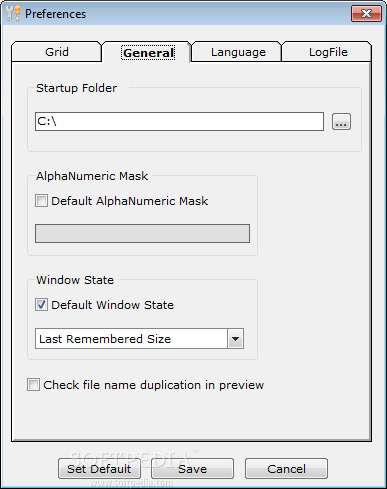
If you are keeping the software and want to use it longer than its trial time, we strongly encourage you purchasing the license key from Winsome.File.Renamer.7.1.Serial-RED official website. Our releases are to prove that we can! Nothing can stop us, we keep fighting for freedom despite all the difficulties we face each day.
Last but not less important is your own contribution to our cause. You should consider to submit your own serial numbers or share other files with the community just as someone else helped you with Winsome.File.Renamer.7.1.Serial-RED serial number. Sharing is caring and that is the only way to keep our scene, our community alive.
From Winsome Technologies:
File Renamer Download
File Renamer For Windows 10

File Renamer is a batch renaming software that renames multiple files in a few clicks with 50+ possible renaming actions. Powerful yet simple and easy to use interface with built-in preview to see new names before you rename. You can also undo renaming. This makes batch renaming extremely easy and you can rename thousands of files in a few clicks only, in seconds. Extremely useful to rename photos using date/time picture taken and other EXIF & IPTC descriptions. Also rename MP3 files using ID3 tag information like artist, album, year, title, composer, Genre, Track number. You can also use external file list created in Text or Microsoft Excel to rename files.
What do you need to know about free software?
Nov 06, 2010 People is often looking for sample powerpoint presentation designs to be taken as reference to create new PowerPoint templates. Often when people search for sample powerpoint templates you can find lot of commonly used templates, this is an original powerpoint design and free powerpoint download. PPT Size: 376.6 KiB Downloads: 96,471. Download free presentation templates and PowerPoint backgrounds. WOW your audience with free PowerPoint templates: Timelines, Roadmap, Diagrams and more.
Winsome File Renamer 8.0 Keygen Windows 10
Read more...

1 note
·
View note
Note
Please god do you have recommendations on the best series to watch
Some of my personal recomendations that I can list from the top of my head, I will be writing a lot of text below so hold onto your horses.
My Life- NatalieFirexx
Still running to this day and in its 12th season. So amazing to see the growth over the years. The first seasons are so funny in a sense of knowing a little Christian emo kid made them, but later seasons have developed into such an interesting story with beautiful visuals, incredible cinematography and relationships that you end up caring about so deeply. Every season has a new storyline to follow and it's always so wild remembering all that's happened in its 10 year run and thinking up what else is to come. Though season 12 is said to be it's final season and I look forward to seeing what Natalie has in store for us after the finale.
The story of My Life follows the Andrews family and their friends in everyday shenanigans, you know, the usual: teen pregnancy, kidnapping, vampires, murder, identity theft, angels, ghosts, hacked kids and love.
(There's also a My Life Abridged voice acting series of season 1 currently in the works, now at episode 5)
Smooth Criminal - SaltPepperSims1408
I always have fun rewatching this. Its only 2 seasons long and once again, a sims series that evolved over it's run. Following Abby as her life goes from normal (if you can call your illegal scientist parents experimenting on criminals in your basement normal) to having visions of her parent's test subject's past and joining his gang where hes the leader and battles a disease that gives him 10x the strength and intelligence of a regular human being. Catch is, this genetic disease is rare and makes you go insane. Most people with it end up insane by 30.
A series with a lot of guns, a badass female main protag, death, once again, teen pregnancy (which will be a common sims series theme), fun dream/vision sequences and in my opinion has a great sense of humour.
SaltPepperSims1408 also has a highly recommended voice over series (though incomplete) titled Apokalypsis, a group of young adults/teens trying to survive in an apocalypse.
CINDER - GrayLeeStudios
Based on the book CINDER by Marissa Meyer. Cinder is a beautifully made voice over series, great visuals, wonderfully told it's story, though it is incomplete at 5 episodes, each running 10-18 minutes. Loosely based on the original Cinderella story but in a futuristic Beijing, adding robots, a colonization on the moon and a deadly plague that has affected the Emperor.
The protagonist is the mechanic, Lihn Cinder. Despite how well known her work as a mechanic is, she is looked down on for being a cyborg and is presented for plague research where she and Prince Kai become closer.
Y O U T H - 1998sims
YOUTH is a retelling of Youth, also a sims series by the same creator that reached its second season before discontinuing. Already a series that dealt with real life issues and involved a lot of representation in its characters. YOUTH is a different experience with all new characters, even more representation and everyone still feeling real in a way where their identities don't define them but are in NO WAY erased at all, like they're real people. When comparing the two series you can see the similar storyline but now its so much fresher and with new characters, their decisions in these situations change. Follows the story of multiple characters in their teen years and learning to deal with being a teen or in some cases having to make adult decisions despite that. Currently up to episode 5 but there is still so much more to come.
1998sims is also the creator behind Avoiding Fate, Its Complicated (currently not available online) and the most iconic series that I HIGHLY suggest you watch; My Sims 2 Emo Teen Pregnancy Kidnapping Story
SOUP - SimFilm
This sims 3 voice over series is brand new, as of this month, with one episode released but I'm already in love with it. It has this deadpan sense of humour I can get behind and I'm really looking forward to seeing where it goes. It appears the episodes will be short and sweet but I really don't mind at all.
Our protagonist, Harris Gold, alphabetizes his life's misfortunes like a can of alphabet soup.
I quote "looks pretty decent on the outside, but when you open the can, you'll simply want to kill yourself"
The filming is wonderful, I love the voice actors and how well they play their roles, the story so far is fun and silly but deals with really strong issues other teenagers might have experienced growing up. Kind of like laughing the pain away and I adore it.
Raison D'etre - Cornymio
I haven't watched a lot of sims 4 machinima if im to be honest (since life to death stories are so rampant on YouTube at the moment and I'd rather just avoid them) but this series was very well made. Only 2 episodes but the voice acting is amazing, the sims custom animations are wonderful and at times the sims can be almost perfectly lip synced to the voices. Has an indie film vibe that I adore, very calming and I adore the camera work. This is a revamp of the creators old Sims 3 series by the same title.
Reine Reynolds enrols herself into a new school, here we meet a variety of students who are all relatable in one way or another with different relationships amongst themselves. A nice watch and won't take long to get through.
Marry Me! - Tickled007
This is actually a companion piece to Marry You by Maot Productions. Marry You has more episodes and progressed it's story much further but personal preference I like Marry Me!'s characters and humour better. Not a fault to the creators though, since I believe they wrote both stories together and I do still recommend you go watch Marry You as well, just my personal taste. I also watched this very recently which is probably why it's on my mind rn.
Marry Me! Is a 2 episode long (so far) voice over series that's quite high energy, it's about a loud "bitch" fashion designer called Serafie and a "pushover" called Carmion. Two opposites that somehow cross paths and after a money hiccup, Seraphie demands that Carmion marry her. I love how silly it is, very kdrama inspired. If you can get past the overused swooping sfx in episode one (which drove me insane but will go away in episode 2) I think it's super enjoyable.
Tickled007 is also the creator of Passcode Unknown, Too Popular and And... Obvious.
I feel it unfair not to mention Maot Productions other creations either since they were also a big part of the Marry Me! Marry You project. They created Sense Me Not!, Corrupted Souls, Cruel Temptation and Retribution
Other simmers and their series that I highly recommend but realise this ask is going to get extremely long
EkolarasMagnum
Their series tend to have this grungy highschool feel to them but I get behind it. They're known for their more interesting sims style, some people love it, some people hate it but it shouldn't get in the way of the interesting stories. I used to adore their work so much as a teenager!
- Advocated
- Strangers
- Volatile
PumpkinsAtTheDisco
Made a variety of sims series based on books (before these same books were made into films) such as the Hunger Games. This creator is incredibly talented from filming, writing to composing their own music. You can really see their improvement over the years too. I love their work.
- The Hunger Games
- Miss Peregrines Home For Peculiar Children
- Dimension 17
- Post Icarus
- Harry Potter and the Cursed Child
StarsToShinex
Their concepts are fun and they have good voice actors. Their filming and editing is nice but their work does have an anime feel if that's more your taste.
- Spotlight
- My guardian
- My guardian- the next chapter
- Seeking Faith
- The last day
MajesticFilms
Their aesthetics are lovely, they make a lot of visually pleasing machinima. I admire their editing.
- Paper Boats
- Arsonist's Lullaby
- Sounds of Silence
- Machinima playlist
ViNtAgELovv11
Still works on videos now and I adore their work, been around for 10 years and only continuing to improve. I believe their most known series wou lkd have to be wasteland but please check out their newer works too!
- Scum City
- Wasteland
- Wonderland
- Runaway
- ROADS
There are so much more and i might make a pt.2 or something along those lines one day since this ask is getting long. But I also have a list of simmers and series on my navigation page if you want to search through some more works.
31 notes
·
View notes
Photo
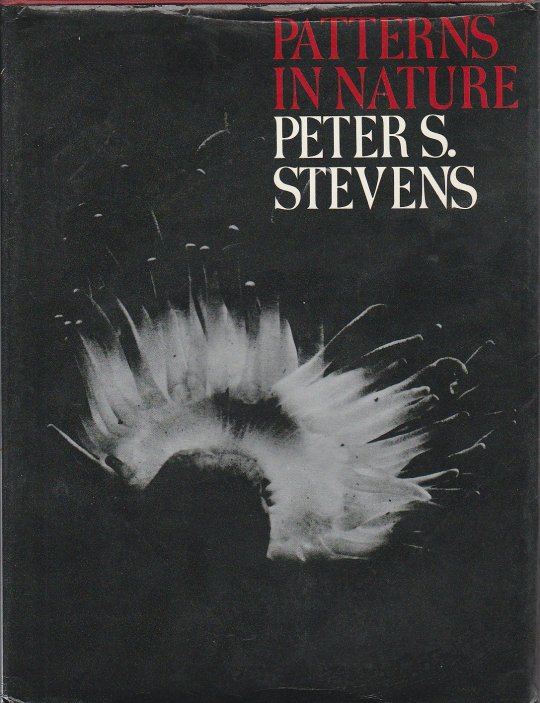

thoughts on “alphabet” by inger christensen
Recently I came across a book titled Patterns in Nature by Peter S. Stevens and I was enthralled. In it, pages and pages of black and white leaves, atoms, veins and rocks unfurled; showing how delicately interconnected everything is, how patterns repeat themselves on every level of life. These were the first images that crossed my mind when I first read Alphabet.
Usually I prefer free form poetry but I was deeply touched by this beautifully crafted piece that happens to be a great example of ‘systemdigtning’ (systematic poetry). Here, the structure (that follows both the alphabet and the Fibonacci sequence) is not only a vehicle for interpretation, it is the heart of the poem. I won’t delve into details or an in depth analysis of this structure, rather I will give you my thoughts and impressions.
First thought : layers of an onion, peeled off one by one; rims of a tree, a testament to life.
It seems at first, like a list of random elements, without much coherence. But by naming them, the poet gives them life and form; through them we see existence flourish before our eyes. The poem follows its own structure and as such Christensen demonstrates that poetry (in the same way as science or mathematics) can bring order to chaos; that words can be used to tame and make sense of this chaos called life.
Yet, as she weaves life through the poem, the poet methodically undoes it. There is a sense of dread that permeates through the whole piece. The most flagrant sign of it is the mention of poison or poisonous elements at multiple points throughout. The line “this poisonous, white, crumbling poem” perfectly crystallizes this idea. Poison is present in nature everywhere and at every scale, the end of the poem signifies to me that perhaps humans are the most poisonous of all. A reminder that out of nature destruction can be born.
The structure magnifies this frenetic dance of life, towards its tragic end.
Up until we reach the bomb, the words are buoyant and vivid, and then we are suddenly confronted by the coldness of numbers. As if the world slowed to a halt, and was covered by the thick blanket of death. This signifies that the power of destruction that man possesses is greater than what constitutes life itself.
This evocation of the atomic bomb brings to mind Marguerite Duras’s Hiroshima Mon Amour, however that text delves more, in my mind, into the link between death and eroticism, whereas Alphabet, with its emphasis on nature, speaks to me on a deeper and more personal level.
To me, this poem is about loving life fiercely and learning to let it go. It is a list of all that is cherished, remembered, hated and questioned; all that matters to us, but will pass us by eventually, be it by our own doing.
And so, at the end of it, I am left to wonder : how can I go on living knowing that everything I love will certainly die ? And what if it is by my own hand ?
Yet there is a note of hopefulness at the end of the poem: since it stops at the letter n, we are left to imagine all that goes beyond this destruction and death. In a way, there is no true ending.
Keywords :
life
structure
patterns
micro/macro
poison
order/chaos
existence
destroy
nature
death
2 notes
·
View notes
Text
Some info about Aylaan
Since I use some of this conlang in my title thingy and the banner image, I figure it might as well be the first one I start to explain.
Most of my conlangs are a part of a setting I’ve been slowly developing for years that’s an alternate future of Earth where some apocalyptic shit happens and it gets so bad that some people lose their spoken languages and replace them a few generations later. I might explain that more in a different post. Aylaan is a descendant of one of the languages that finds its origin in this time. I’ll discuss it at the time of humanity’s largest interstellar war to date, which is a war between a colony that fell victim to a cult’s control and the rest of our inhabited stars. It’s the most commonly spoken language in a large part of North America, centered around the southwestern United States but extending as far as the Mississippi River. Aylaan is written with the Hacik alphabet, which first came into use sometime shortly after the Great Collapse. I don’t have a good digital representation of it yet (the sample in the banner image was hand drawn in paint.net) so maybe I’ll discuss it in more detail later. The grammar gets kinda crazy so I’ll probably discuss it one piece at a time over a bunch of different posts. For now, I’ll just cover the phonology and the romanization and some other basics.
Consonants:
/m n ŋ p t k q t͡s t͡ʃ pʼ tʼ kʼ t͡sʼ t͡ʃʼ ɸ θ ð s z ʃ ʒ x ʕ h r l j/
<m n ň p t k q c ć ṗ ṭ ḳ c̣ ć̣ f þ ð s z ś ź ç ɣ r l y>
/m n ŋ p t k q l/ may be geminate between syllables
...I go back and forth on whether to list [w] as a phoneme and the diphthongs involving it as vowel-consonant sequences or to list it as an allophone of /ʊ/ when it occurs in diphthongs. In my documentation I use w in the romanization but I go back and forth between w and u in actual practice, so a sequence [aw] may be written <aw> or <au>. I suppose I’d be more inclined to analyze some dialects one way and others the other way, there’s a bit of variation in how vowels are treated.
Yes I romanized x as ç, it was an early aesthetic choice which I’m less sure about now but haven’t bothered to change, don’t @ me lol
Vowels:
Vowels vary somewhat by dialect. In most cases the vowels can be listed as simply /a e i o u/ with long and short variations, but in the standard dialect, short vowels have quality differences too and in western dialects, the quality distinction is used to the exclusion of length. (The further east you go, the more it relies on length, until in the far east, the quality shifts haven’t actually taken place and the sole distinction is length.) I will therefore list the vowels as they occur in the standard dialect:
/a ɒː ɛ eː ɪ iː ɤ oː ʊ uː/
Diphthongs may only form in short vowels, and only pairs of short i or short u and a different vowel may exist (hence my indecision when it comes to listing these as vowel pairs or sequences of a consonant and a vowel.) I’ve used w and j in the phonemic transcription here, and I’ve also used the short-vowel qualities, mostly for my sanity.
/ja aj jɛ ɛj jʊ ʊj jɤ ɤj wa aw wɪ ɪw wɤ ɤw wɛ ɛw/ <ya ay ye ey yu uy yo oy wa aw wi iw wo ow we ew>
Primary stress falls on the first long vowel or diphthong, before the first geminate consonant, or, if none are present, the initial syllable.
Syllables can have an onset containing up to two consonants which either follow a sonority hierarchy or are a reversal of a voiceless stop /p t k q/ and a sibilant fricative /s ʃ/, i.e. a cluster like /st/ and an onset of up to two consonants which also follow sonority hierarchy. This may result in gemination if the onset of one syllable and the coda of the previous match and are single consonants. Long vowels never precede geminates.
Word order is verb-initial with descriptors that follow what they modify, indirect object (...usually) last, and some complexity involving obviation and a person hierarchy. Basically, the lower one on the hierarchy must be after the higher one in the word order, then agent and patient is marked by direct or inverse voice. The lower in the hierarchy is typically marked with an obviate, but a special proximate marker only occurs in inverse voice. Subject pronouns most often drop in direct voice.
I’ll give an example of each with the same nouns and verb:
Mene þaayareň.
seek-1S ring-OBV
Menoþelir ňa e þaayareň.
seek-3S-INV PROX 1S ring-OBV
“The ring seeks me.”
Since an inanimate object seeking someone is unusual, this takes a lot of funky marking to indicate that this is actually what’s happening. This is of course not a full explanation of this system, that would take a lot of space that I don’t want to use here.
This language has been in progress for close to 15 months I think. It’s the most developed in its family. I started the proto-language sometime early last spring. I have several other languages that are related to this one and I’ve been slowly expanding the family. I’ll showcase its relatives, and my other conlangs, like this at some point.
2 notes
·
View notes
Photo

Avestan
Avestan is the name of two related, but temporally quite removed ancient dead languages belonging to the Iranian branch of the Indo-Iranian superbranch of Indo-European languages: Old Avestan, spoken in the 2nd millenium BCE, and Young Avestan, spoken in the 1st millenium BCE.
{{ IE > IIr. > Ir. > Avestan (Av.), Old Persian (OPers.) }}
The name refers to the corpus of Zoroastrian religious texts which is the only source of these two languages – the Avesta (of uncertain etymology). Old Avestan is also called Gatha Avestan, as it is principally attested in hymns (Av. gāϑā- ‘hymn’) believed to have been composed by Zoroaster/Zarathushtra – the spiritual leader whose teachings are the foundation of Zoroastrism – himself.
Zoroastrianism is among the oldest religions still alive today, with between 100 000 and 150 000 adherents mostly in India and Iran.
Old and Young Avestan
Many scholars believe that the languages weren’t only temporally removed, but that Young Avestan was descended from a different dialectal base than Old Avestan. Even so, the possibility that they are directly related is viable too, as the problematic aspects of the relationship between them could be due to the compex history of the written texts.
Though from different time periods, both Old and Young Avestan were recorded at the same time, long after both languages have already gone out of use. The texts as we know them were first written down some time after the 5th century CE (likely around 600 CE) and the copies that have survived and are available to us are, at the earliest, from the 13th century, but mostly from the 16th–18th centuries, some even from the 19th century (well over 2000 years after they were first composed). Since their creation, they were thus orally transmitted from Old Avestan speakers to Young Avestan speakers to those whose native language was neither of them, with corruptions that happened in oral transmission (e.g. application of YAv. sound changes to OAv. words, incorrect archaisations, overlong pronunciations in liturgy etc.) and later in written transmission as well (e.g. scribal mistakes, scribes replacing a word unknown to them with one they know etc.).
It should be mentioned that the texts that have been preserved and are available to us represent only about ¼ of the titles listed in the bibliography of the entire Avestan corpus.
Avestan alphabet and transliteration
Avestan alphabet was developed from the Pahlavi script, with some of the signs taken from Book Pahlavi, some from Psalter Pahlavi and with many innovations. The alphabet is highly phonetic and reads from right to left (←).
The script in Hoffmann transliteration:

{Taken from Gippert (2012); Unicode has codified the script, but it is not supported on most sites, including Tumblr}
Notes:
the transliterations with a dot above (ą̇, ġ, ẏ) generally represent variant signs for the same sound of which only one is used in the same text, however:
there are some indications that ą̇ may have been short (from nasalised ə) and that ą was long (from nasalised long ā), but the evidence is very scarce;
the sign ġ most often appears in the word-final sequence ṇġ and there are suggestions its pronunciation might parallel that of word-final t̰ – that would of course go for regular g in this sequence as well;
the sign labeled as y here (not ẏ!) can – when not used to represent the sound [j] – be used as a sign for ž as well (originally probably actually its own sign for ž́);
though both short diphthongs [ai̯/ae̯] and [au̯/ao̯] (see below) use the long vowel signs to represent the second part of the diphthong: a+ē and a+ō, they are traditionally transliterated as aē and (!) ao;
a sign for å (from short a, unlike ā̊ from long ā) has very limited attestation – it is constructed similarly to ā̊, which is ā+ə, so a+ə (one “υ” wiggle less at the beginning of the sign :þ); some use the transliteration å generally (presumably because it’s easier to type), not differentiating between å and ā̊;
the middle dot · functions as a word separator – it is only transcribed (as a regular dot . ) when it divides parts of a compound; the triple dot ∵ marks the end of a sentence.
The text in the picture at the top (YAv., from Videvdad 2.10: the story of Yima) thus reads:
araz·aiirβus·t̰auušiβia·mąz·mąmi·ōh·m
-m hō imąm ząm aⁱβi[š́]uuat̰ suβr[a]iia zara-
“...] He moved towards this earth with a shepherd’s stick adorned
jōaiitiu·aiirtša·t̰afis·məd·auua·aiińian
-naⁱńiia auua d[i]m sifat̰ aštriia uⁱtiiaoj-
with gold. Against him you swished [your] whip, saying:
v·auuaš·acarf·itiamrā·atṇəps·aϑirf·ōna
-anō friϑa spəṇta ārmaⁱti fra(=)ca [š́]auua v-
‘O dear invigorating devotion, go forwards (and)
·acmąnarōats·acmąuusap·erϑərəb·ahŋamən·acī
-ī(=)ca nəmaŋha bərᵊϑre pasuuąm=ca staoranąm=ca
go away, carrying cattle small and big [...’ ”
In the transcription, restitutions based on other texts and etymology are in with square brackets and enclitics are separated by the = sign.
Avestan phonology
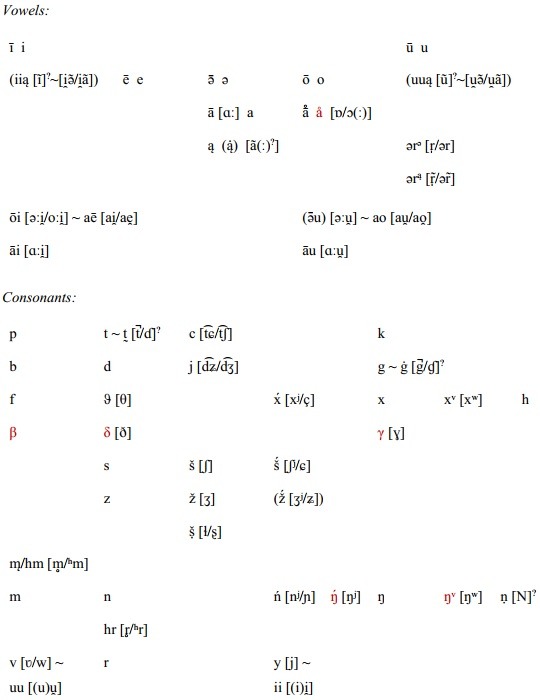
Notes:
when the signs do not correspond to their IPA value, their pronunciation is noted in square brackets, except for the length in vowels, marked with a macron ⟨◌̄⟩;
in red are YAv.-only phonemes; the palatal(ized) sounds (x́, š́, ń) and xᵛ were conditional allophones in front of *i̯, *u̯ (with x́ and xᵛ as allophones of h, not x!) in OAv., but at least š́ seems to have been phonemicized in YAv.;
the phonemic status of mid vowels (ē̆, ə̄̆, ō̆) in OAv. is also dubious;
the short and long vowel pairs could have represented a simple distinction in length, though some also postulate some kind of a distinction in quality (be it of the type [eː]:[ɛ] or [ɛː]:[e]); the quality distinction in the case of ā : a (as [ɑː]:[a]) is more generally accepted, though as initially said – not necessary; for the length distinction between ą and ą̇ see above;
r had a syllabic allophone [r̩/ər], written ərᵊ, with ą as the second written vocalic element when nasalized [r̩̃/ər̃];
i and u might have had nasalized allophones as well, though evidence is scarce;
the pronunciation of t̰ is not clear – it is most often seen as unreleased [t̚], though other proposals (such as implosive [ɗ]/[ɗ̥]) exist as well, cf. OPers. ᵗ; it is likewise possible that some word-final g/ġ were unreleased, including the possibility that the spelling -gᵊt̰ might indicate unreleased k, though – unlike t̰ – this is not generally accepted;
the ṣ̌ sign (representing earlier [r̥t]<[rt]) probably at least initially represented [ɬ] (or perhaps [r̝̊]) and later [ʂ]; by the time the texts were written down all of š, ṣ̌ and š́ have most likely merged;
the pronunciation of ṇ is not clear – proposals range from uvular [ɴ] to homorganic nasal (i.e. pronounced at the same place of articulation as the following consonant) to a nasal segment of a preceeding vowel (but consider the use of ą to mark nasalization in the cases discussed above and the sequence aṇ, where ą would be expected if it were pure nasalisation; perhaps rather late nasalisation, e.g. [a͜ã]), cf. also the Devanagari transliteration as ्ँ and OPers. ⁿ.
Some distinctive features: • IIr. *s becomes Ir. (including Avestan) h, except when in contact with an obstruent and in front of n and (only partially) r • Voiceless stops become voiceless fricatives in front of another consonant (except after s/š; except the cluster pt, which does not become ft as expected) • Epenthetic* i as a sign of (pre-)palatalization (e.g. *aβī > *aβʲī > aʲβī ⟨aⁱβī⟩) and u as a sign of (pre-)labialization (*paru- > *porʷu- > poʷru- ⟨poᵘru-⟩) • Anaptyxes* in hard-to-pronounce clusters (e.g. OAv. dugᵊdar, but YAv. duγδar; YAv. fᵊδrōi) • YAv. “spontaneous nasalization” in the -ā̆h(r/i̯/u̯)ā̆- sequence, which thus becomes -ăŋh(i̯/u̯)ā̆-/-ā̊ŋh(i̯/u̯)ā̆/-aŋrā̆- (producing the apparent sound change *s > ŋ / _r) • YAv. lenition of b, d, g to β, δ, γ in non-initial position • (Probably retroactive) lenghtening of all word-final vowels in OAv., while all YAv. word-final vowels in polysyllables were shortened and monosyllables were lenghtened ...
*Though both anaptyxis and epenthesis here refer to an (apparent) insertion of a vowel, as used by the scholars, “epenthesis” is used for i and u specifically and “anaptyxis” otherwise.
Avestan syntax
Avestan is an inflected/fusional language with free word order. A typical representative of an old IE language, Avestan has:
3 numbers (singular, dual, plural; with dual giving way to plural with time),
8 cases (nominative, vocative, accusative, instrumental, dative, ablative, genitive, locative; with case syncretism more common with time, especially in dual and plural),
3 genders (masculine, feminine, neuter)
3 persons (1ˢᵗ, 2ⁿᵈ, 3ʳᵈ),
3 tenses (present, aorist, perfect; in YAv. aorist is rare, the past tense is instead formed from the present: present injunctive ~ “imperfect”, while perfect can also be formed periphrastically),
2 voices (active, middle; passive can expressed with the middle voice or with a suffix),
5 moods (indicative, imperative, injunctive, subjunctive, optative).
Avestan reflects a number of archaisms with regards to Vedic Sanskrit, such as the preservation of many more PIE accent-ablaut paradigms and heteroclitic nouns (nouns with an alternating suffix: -r- in the strong cases, -n- in the oblique), the disyllabic reading of long ā in the thematic subjunctive and the “Hoffmann suffix” nouns (indicating that a laryngeal used to be there), as well as other more specific ones, for example the preserved distinction between genitive and locative in dual, etc.
Young Avestan shares some innovations with Old Persian, such as the neo-ablative, the periphrastic perfect, the “habitual” (= augmented optative) …
Sources used:
• Gippert, J. “The Encoding of Avestan – Problems and Solutions” in: Altüberlieferte Sprachen als Gegenstand der Texttechnologie / Ancient Languages as the Object of Text Technology = Journal for Language Technology and Computational Linguistics 27/2, eds. Jügel, T. and Hoenen, A. Gesellschaft für Sprachtechnologie und Computerlinguistik, Berlin: 2012 {available online};
• Kellens, J. “Avestique” in Compendium Linguarum Iranicarum, ed. Schmitt, R. Ludwig Reichert Verlag, Wiesbaden: 1989;
• Kellens, J. and Pirart, E. Les textes vieil-avestiques : II. Répertoires grammaticaux et lexique. Ludwig Reichert Verlag, Wiesbaden: 1990;
• Martínez, J. and de Vaan, M. Introduction to Avestan. Brill, Leiden: 2014;
• Skjærvø, P. O. An Introduction to Young Avestan. Self-published: 2003;
• Testen, D. “Old Persian and Avestan Phonology” in: Phonologies of Asia and Africa (including the Caucasus), ed. Kaye, A. S. Eisenbrauns, Winona Lake: 1997;
• de Vaan, M. The Avestan Vowels. Rodopi, Amsterdam: 2003;
• articles about the Avestan language in Encyclopædia Iranica by K. Hoffmann and J. Kellens {available online: 1, 2};
• relevant pages on Wikipedia;
• my own notes from “Old Persian and Avestan” class.
— permanent link —
#j#pide#avestan#iranian#indo iranian#indo european#young avestan#old avestan#yes this will be a series#but don't expect it to be regular#i will always post the next one only once i have another one practically ready#so it'll be quite some time between these#edited: 5. 1. 2020
37 notes
·
View notes
Text
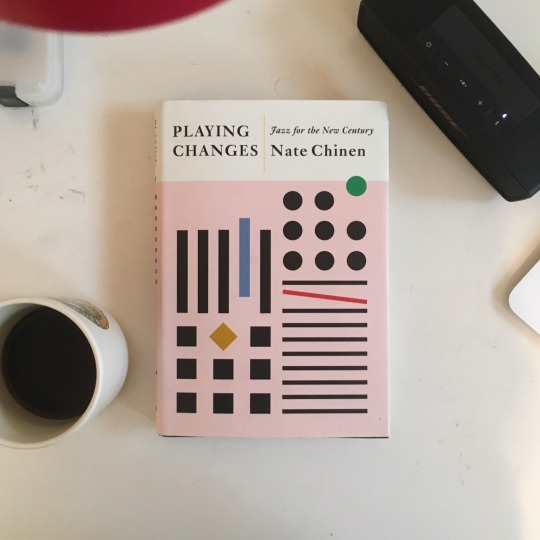
#finishedbooks Playing Changes: Jazz for the New Century by Nate Chinen. Was thinking I would make a list of my favorite books I read this year as this would be up there. Finally an argument for contemporary jazz that completely changed my opinion. I always said I never listen to anything beyond 1970, roughly the time of the onset of the affront to jazz called fusion. I was scared this would be an attempt to make a case for the commercially motivated genre but far from it and it doesn't even bother with smooth jazz, Kenny G and the rest for that matter. Then I thought this would just be an extended biography on the uppity Wynton Marsalis or much deserving Kamsai Washington and of course it but there was just so much more! Where does jazz go from the 60s? I have found that rather than evoke the past from a stance of deference, there has been a slew of artists that with a fresh intellectual rigor have been able to create anew within a recognizable framework in ways that feel ecstatic and unbound. This point was my criticism of Robert Glasper as it was never that I didn't enjoy his music it was that I enjoyed his music the same way I enjoy Dilla's, which is different from the way I enjoy Thelonious Monk's. Perhaps to better explain this there was an excerpt from another recently written book where the author points a conversation between the post-structuralist Jacques Derrida conversation and the late free jazz pioneer Ornette Coleman. Coleman says, “I’m trying to express a concept according to which you can translate one thing into another. I think that sound has a much more democratic relationship to information, because you don’t need the alphabet to understand music.” Derrida responded, "But if I translate what you are doing into a domain that I know better, that of written language, the unique event that is produced only one time is nevertheless repeated in its very structure. Thus there is a repetition, in the work, that is intrinsic to the initial creation—that which compromises or complicates the concept of improvisation.” Really wordy, but in short the point is a word isn't a word until it is repeated and the contextual circumstances that this occurs in creates structure...but it can't exist without repetition as with a musical sequence. Based on the repetitions of jazz there was an order but fusion was so alien to me, a remedial variation of the jazz language that I thought it just couldn't go any further. The author breaks down the preconceptions to this notion by pointing out the deficiencies in Ken Burns' Jazz documentary and various institutions with its subsequent archival treatment of the genre and the important implications of what is now a globally jazz economy. Because like language and within the structure, the book shows not only the refinement but simultaneous expansion it has gone through to the present (2018) when the book was released. Out of this I have been reading chapter by chapter that catalogs movements under the rather diverse umbrella of jazz that incorporates its ever evolving elders like Wayne Shorter, the M base approach that featured Steve Coleman, the reductionism of pianist Brad Mehldau, the true contemporary art approach of Jason Moran who draws connections across style and medium, to overseas players that exhibit the unselfishness of Polish trumpeter Tomasz Stańko to Japan's late great Masabumi Kikuchi, and of course Robert Glasper and especially the soulquarians who first got me curious about jazz as a teenager. There was so much more, but what an exciting discovery searching each artists' work on the internet and discovering the playing changes of the last 50 years as the title suggests.
6 notes
·
View notes
Text
“B”een There
done that.

So here ends my time playing games that start with the letter B. Thanks for reading! It's been three years plus change. Back in early 2016 when I pondered how the world might look when I finished another letter, I never imagined, even from that unsteady ground, just quite how different things would become (in terms of global political-psychological landscape) - though really all the top-down drama happened that year, and everything since then has just felt like the normalisation and ratification of it, this splintered-systemic madness, the post-parody, post-fake fake-real. Or whatever you want to call it.
Nor did I imagine that it would take me so long. But, life. I went overseas, moved houses, moved cities, went through a breakup, started a PhD, rode a bike, read some books, faffed around. I anxiously played hundreds of hours of Rocket League; I ticked off every achievement in Mini Metro; I spent too long trying to remember what I was doing in Stardew Valley. I reviewed some games over at Gamecloud, which wrapped up earlier this year. Time accumulated in a predictable but upsetting way.
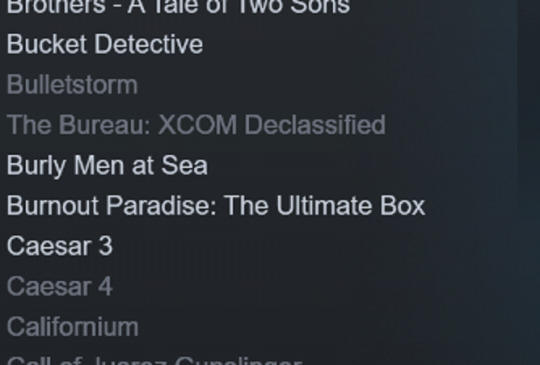
Beloved demigod of gaming blogs RPS went through a full staff turnover, pretty much. It's weird, man. VR happened but remains a bit beyond my periphery, even if it gets brought up from time to time in the groupchat. Battle Royale games weren't a thing a few years ago, then they became everything, now they are still a big deal, the biggest deal, or maybe a large-medium deal, or just a large part of the background - I honestly don’t know how to quantify this. Steam's ubiquity has slipped markedly, through a mixture of managed negligence and increasingly aggressive competition. The inherent limitations of being bound to one commercial distribution system on one hardware platform have always been at the back of my mind, but I do increasingly wonder if my time would be better spent on a project that dug through other veins. The answer is, for now, that sometimes you've gotten keep doing the thing you said you were gonna do, if no other reason than because.
Tumblr, our home since 2016, has gone through its own shifts and controversies in this time too. They no longer seem to allow unencoded links (so no-one ever knows what they’re clicking on), it became less friendly to adult content, and as of today apparently Tumblr has been sold on to wordpress. I don’t really know the implications of this last thing.

Some Maths
I played fifty one games beginning with B. Of the forty-eight that I'd deem to have some notional metric of completability, twenty-four of those I (often in the most flexible sense possible), "completed". 50%: Not as bad as I'd expected, TBH, especially as that includes a couple of painful six/seven game streaks where I didn't finish anything.
Ceremonious Award Giving for Games Starting with ‘B’
It is always hard to pick favourites, and from any given vantage point they tend to change. Nevertheless, an act of self-canonisation is in order, as is tradition. Given the nature of this project, I do put a lot of value in titles that surprise me in one way or another. Batman: Arkham Asylum and Bulletstorm were equal Best Goofy Action surprises (it pays having low expectations, sometimes), with an honourable mention to Brigador. The Banner Saga was the most surprisingly thought provoking. Davey Wreden’s autoficitive The Beginners Guide gets the Anodyne Prize for Most Enjoyably Difficult To Put In A Box.
Botanicula was probably my Favourite (total) Revisit, or the best non-surprise.
B was a letter characterised by a few high-budget action series (of which my favourite part was Bioshock 2 (Minerva's Den)), held up by substrate of modest indie things of varying impact. My attention span was all over the place, too. We had a lot of short forays with little to say, but there was there were also more than a few wordier attempts at thought. I'm bad at judging what makes "good" writing, particularly of my own, which I oscillate between accepting and loathing, but I can tell you which games/posts took the cake for length and effort: Baldur's Gate for longest playtime; Burnout: Paradise for highest word-count (and longest gestation period); Battleblock Theater for the most time-consuming method of putting a post together; The Beginners Guide for the most times played through a game in order to try and parse it; Braid for the most external reading and referencing.
I think the most absurdly Expensive-at-purchase game here was Battlefield: Bad Company 2, which also gets the newly thought of I Can’t Believe It Still Has Functioning Online Multiplayer prize. I'm handing the Most Disappointing badge to Broken Age, despite (or because of) already having played it a bunch before attempting it for the list, though Before the Echo (fka Sequence) takes the Aquanox Award for game I inexplicably sunk the most time on trying to finish despite not really enjoying. I hold the Most Contempt for Breach & Clear. Black Mirror had the Worst Voice Acting, and it was also the Oldest Game here (2003), at least in terms of no-significant-alterations though depending on how you want to factor in remasters and remakes, you might alternatively give that prize to Broken Sword (1996) or Bionic Commando Rearmed (1988). Blueberry Garden was Purchased Most Long Ago, in 2009, though the Aquaria Trophy for Longest Unplayed Incumbent goes to Bob Came in Pieces, which I'd bought in 2010 then never installed (it's pretty good, it turns out!). However, the special Emotional Closure Award goes to Baldur's Gate, with which I already had nearly two decades of fond, scattered memories, before finally finishing for the first time during this project.

More Maths
When I started this letter I had 438 games in my steam library. Right now I have 1049 games, which is almost exactly three times the amount I had when I started this blog in October 2015 (~350). I've played 70 games total. A further 57 entered the list behind the marker, into the exempt scorched land of the already visited alphabet, which means we're at 127/1049 = 12.11% of the way through the list, which is a +7% increase on where we were at three years ago. That's not nothing. But at 2.5% per year, it's not a lot. Globally, the average human lifespan is 68 years.
Terrifying Implications For the Future
The maths says that the current terms aren't working, that I'm drowning in a heady mixture of my own relentless consumerism, hesitation, and procrastination from this task which is itself an avenue of procrastination - that at this rate I will probably die (or certainly give up) before even getting to the halfway point, and that we can't continue like this in good faith.
So I'm going to get a bit reckless, even change the rules slightly, in order to try and breathe new life into this thing. All games must still be played for at least an hour - yes, that one stands. But. BUT. I'm setting a hard time limit of one week, from one game to the next, post to post. For now at least. No more lofty words about striving to "finish" games as a rule rather than exception. It's quantity over quality (pretending for a second that quality was ever a concern) from here on out, business over pleasure, irreverence over lengthy considerations, scrapbooking over essays.
On the bright side, this means I can have a weekly posting schedule. Let's say Tuesdays? Tuesdays seem like a good day for posting.

A couple of other things:
List Oriented now has a ko-fi tip jar, just in case you, dear reader, enjoy this blog - or did before it went completely silent for the first half of this year - and feel like helping to pay for my caffeine addiction and/or encouraging me to keep going with this task.
Another thing I want to do is compile a list of links to good places for games-writing and other things that I like, because a) I feel like such a page would be helpful for me to keep a record, even if for nobody else; b) my conception of the internet is permanently stuck in 2008 but also; c) it's hard to remember where to look for good things on the internet, sometimes, these days, given our habitual over-reliance on various platforms to direct us to CONTENT. But one thing I want to include is a list of other places where people are doing this kind of list-oriented project thing. I remember a bunch of them sprung up a couple of years back when we gained a brief and relative flash of notoriety, though I’m not sure how many stuck at it. If you yourself are doing one, or you’re aware of any others who are, Let Me Know!
Anyway, looking ahead. C. An obtuse but interesting letter. Not so many of the big-hitters. A buuuuunch of city builders and management games, a few influential and/or janky platformers, more than a handful of puzzlers, some famed RTS series, a heap of question marks, a coupla interesting art things and a few uh *squints* Shooting Game. Happily for me, a lot of titles that I've not yet gotten round to giving a go, so this will be all...fresh.
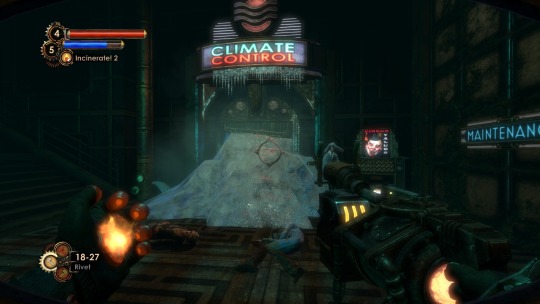
I have a vague memory from when I got through A, of looking ahead to C and thinking at least it was a much more compact section than B, at the time, some light on the other side of what I'd already known would be a slog. But here we are three years later, and now there's fifty seven such games beginning with C, so there goes that thought. You'd think, having identified the consumerist-excess problem that catalysed this stupid thing, I would have stopped buying game bundles at some point, made this ridiculous project a bit easier for myself, a little more plausible for everyone else.
But, we must continue. It's a new day. A new letter. A new schedule.
The way is long and it is littered with videogames.

above: “celebrating” my “achievements” with a ‘b’eer
#sitrep#the letter b#steam#steam list#batman arkham asylum#bulletstorm#brigador#the banner saga#the beginner's guide#botanicula#minerva's den#baldur's gate#burnout paradise#battleblock theater#battlefield bad company 2#before the echo#broken age#breach & clear#blueberry garden#bob came in pieces
4 notes
·
View notes
Text
The Lustrous’ writing system

(contains minor and major spoilers from the manga!!)
Writing and reading are recurring elements in Houseki no Kuni. Phos’ first job is to write an encyclopedia and we know that the gems possess a vast library. Writing is so important that Peridot’s main occupation is making paper for other gems to use, just like Alex’s job is being a scholar and writing about Lunarians.
Also, while Admirabilis, Lustrous and Lunarians seem to share a common language, they do not share the same writing system (when showed a dépliant of the Moon facilities, Phos is unable to read it). So which script do the Lustrous use?
Since it’s sensei that educates the gems in writing and reading, we can assume that he taught them a type of script that humans used when he was originally created, so we can try to identify it starting from the scripts that exist today.

First of all, there are many types of writing systems, each with their own conventions, and they are classified according to what the different symbols of the system stand for. While linguists still kill each other in their sleep over classifications criteria, for the sake of this post I’m going to adopt a simplified version of Daniels’ classification. So we have:
Logographic: like Chinese, each symbol is a morpheme (a single unit of meaning, like 王, king)
Syllabic: like Japanese kana, each symbol is a syllable (け, か and こ, ke, ka and ko)
Alphabetic: like our Latin alphabet, each symbol is a distinct phoneme, vowels included (like A, B, C etc)
Abugida: or alphasyllabary, it’s in between Alphabetic and Syllabic, sequences of consonants and vowels are written as a unit like in Devanagari and Tibetan ( क् + प/ पे = क/ कॆ, K + a/e = Ka/Ke)
Abjad: like the Alphabetic, but symbols are only for consonants, like in traditional Hebrew and Arabic (ב ,ג ,ד, B, G, D)
Featural: the shape of the symbol resemble that of the sound, like in Korean Hangul (like ㅁ, M, that looks like a mouth)
Another thing to account for is the direction of writing: when the gems write they go top to bottom, vertically and right-to-left like we can see from these pictures:

Pic 1 is of one of Alex’s drawings: the paragraphs align on the right side of the paper, while there’s room left on the opposite side of the sheet, at the end of the second paragraph. The second pic is of Rutile: while it looks like they’re taking notes left-to-right, they could also be editing what they just wrote because the entire page is already densely written. Also notice how they write with a stylus, not a brush, because this detail will be important later.

Similarly, here we have Ghost, Sensei and Phos reading right-to-left, starting from what would be the last page from a Latin script user’s point of view. Notice how the titles of the books are on the left of the binding. Sensei is also reading right-to-left: this is from the panel where he’s teaching a new book to young Phos so he’s reading the first pages, the ones on the right.
So we have a top-to-bottom, right-to-left script, which hints at the gems’ writing system being based on an East-Asian script, since they’re the ones most often written vertically&RTL.
It would make sense for the Lustrous writing system to be Asian-based: the story is highly influenced by Buddhism and the mangaka is a Japanese woman. Yet, while I do believe that the script the gems use is Asian (or, well, similar to known Asian scripts) I don’t believe it’s Japanese. Let’s look at some examples:

(Lustrous script vs Chinese/Japanese cursive)

(regular Chinese/Japanese vs cursive form vs Lustrous script)
The gems’ script does resemble Japanese and Chinese cursive, but there are a few issues. First of all, cursive is hardly intelligible even for skilled readers, because it is regular writing that was drastically simplified and smoothed out to create a beautiful and abstract appearance: it’s more of an art form than an ‘actual’ writing system. Also, cursive is created by the movement of the brush never leaving the paper, so we would expect the gems to write with a brush when we know that they actually use a stylus.
Finally, since cursive is just a type of calligraphy, we would expect some of the writing we see in the series to look like regular Japanese and Chinese, like the script on the left in the first picture, yet it never does.

(Lustrous script vs Traditional Mongolian)
What we do have examples of are the tidy and geometrical vertical lines that characterize the Lustrous’ script. They write vertically in a continuous swirl of characters that is similar not only to Chinese Cursive but also to another East Asian alphabet, with whom the Lustrous script also shares a lot of other characteristics: Traditional Mongolian, a script derived from the Old Uyghur alphabet, a distant relative of the Egyptian hieroglyphs.
I have a couple of examples to raise my point and they have to do with the few images of single letters/symbols that we see in the series, like the one below, from ep.12.
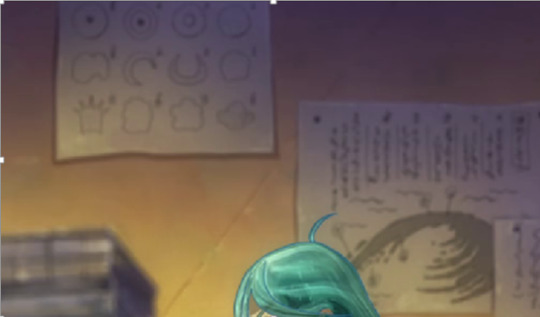
I couldn’t find a higher resolution picture, but look at the paper sheets on the wall of Alexandrite’s room: the one on the left is about the different types of Lunarian apparitions, while the one on the right is about the island where the gems live.
If you squint your eyes a little, you can see that, above each portion of text in the image on the right is a symbol, probably a letter or a number to classify the different types of information. Same thing for the left image: there’s a symbol next to each ‘model’.
When Alex tests Phos’ knowledge, they do refer to numbers to classify the different types of models, so let’s say for a second that those symbols are numbers. Even if the picture is not super clear they are not angular enough to be Chinese/Japanese numbers: 一 十 二 三 四 五 六 七 八 九 十 (1, 2, 3, 4, 5, 6, 7, 8, 9, 10). Now look at Mongolian numbers:

They look swirly and rounded like those in the picture. Also, remember how Mongolian writes top-to-down? If you stack these numerals up in vertical sequences (like in dates or two+ digit numbers) they will acquire the same length of the ones showed in the picture.
Finally, we must also take into consideration the type of script. Remember that very long list at the beginning of this post? Well, how do the gems differentiate among symbols and sounds? Do they use an Alphabetic script like Mongolian or a Logographic one like Chinese? Do they use something different altogether?
Thanks to Phos’ never-ending curiosity, we do have one example of how the Lustrous’ write sounds and it’s from when Phos tried to speak with the Lunarians and heard them saying ‘fu’ and ‘a’:

When they write those sounds down, they use two different characters: one for ‘fu’ and one for ‘a’.
Now, the manga is written in Japanese and Japanese uses a syllabic script, so it can’t write single consonants. Instead, it attaches the vowel ‘u’ (or sometimes ‘o’) to a consonant to suggest that it should be read by itself. So we could think that the ‘u’ in ‘fu’ is mute and that the Lunarian said ‘f’ instead of ‘fu.’ However that ‘fu’ is used to make a joke just a couple of panels later, suggesting that it could also exist as a syllable on its own, not a single consonant.
This would change the type of script the Lustrous use, because if Phos wrote down ‘f’ and ‘a’ (instead of ‘fu’ and ‘a’), then it would mean that the gems use an Alphabetic script, like Traditional Mongolian. On the other hand, if Phos heard ‘f+u’ and wrote down the syllable ‘fu,’ then the gems’ script could be Syllabic, like Japanese or an Alphasyllabary like Tibetan.
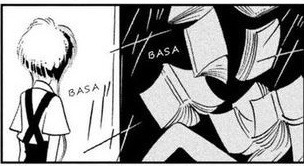
As for other types of scripts, I don’t think they are using a Logographic one (like Chinese), because if they were, then Phos would have written all the different ways in which the sound ‘fu’ could be represented, just like when Japanese speakers tell each other which kanji to use to write their name correctly. This is because each symbol stands for a morpheme (a unit of meaning), not a phoneme (a single emission of sound), so the same unit of sound can be written in different ways.
Phos is looking at the sounds they just wrote to come up with an idea about what they could possibly mean: it would make sense for them to write down all the possible combinations of sounds for ‘fu’ and ‘a,’ not just one.
What we can say for sure is that the Lustrous’ script is not Abjad, because the vowels (like ‘a’) have an independent symbol. And speaking of independent symbols, if we come back to Mongolian for a second, we can see that the symbols for ‘initial fu’ and ‘independent a’ do look a little like what Phos wrote down:

If this were true, then the Lustrous’ script would work like Mongolian: an alphabetic script where letters have different forms depending on their position in a word (initial, medial, final or independent).
There is one problem with Mongolian, though: it’s written vertically, top-to-bottom like the Lustrous’ script, but left-to-right rather than right-to-left. So if the gems are indeed writing in some sort of descendant of the Traditional Mongolian script, then it was modified to allow right-to-left vertical writing, like in a mixture between Chinese cursive and Traditional Mongolian.
For example, the two Lustrous letters above look like a mirrored version of the Mongolian letters below, and that could explain how one system writes RTL and the other LTR.

Among all the existing writing systems that I have analyzed, I think that Traditional Mongolian and Chinese cursive are the ones that resemble the way the Lustrous write the most. Among the two, I believe Traditional Mongolian shares more features with the Lustrous script than Chinese cursive, except for the fact that Mongolian writes left-to-right.
If the gems really did write in a parent script of Mongolian, then it would be interesting to know if they also spoke a descendant of the Mongolian language or if sensei taught them Mongolian script because he was created in Mongolia, but this post is already long enough.
I’d love to hear what you think about the Lustrous script though, and if I made some mistake or forgot to mention something, feel free to add to this meta.
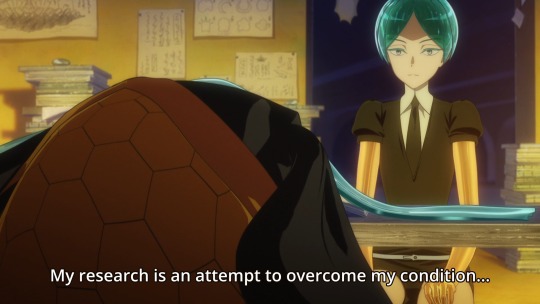
#houseki no kuni#land of the lustrous#hnk#meta#long post#writing#writing system#script#hnk headcanon#mongolian#linguistics#lustrous writing system#meta tag#best
927 notes
·
View notes
Text
Panels Far, Far Away: A Week in Star Wars Comics 6/19/19
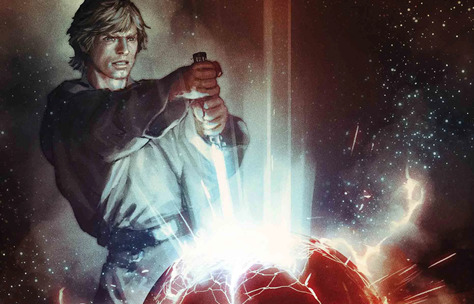
The rebels may be warriors for justice and galactic revolution, but that can’t always be the case, right? Three different Star Wars comics from Marvel explore the gray areas of galactic war this week.
Star Wars #67 written by Kieron Gillen and art by Angel Unzueta
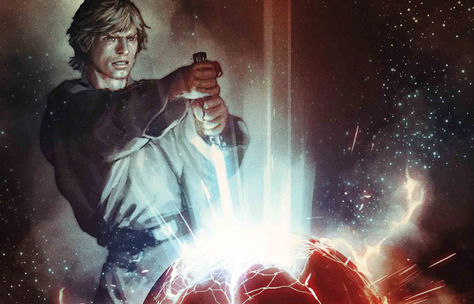
After nearly thirty issues and four years of story, Kieron Gillen’s wild run on Star Wars comes to a close with the climactic finale to “The Scourging of Sho-Torun.”
With Queen Trios dead and the partisans having turned Leia’s tactical strike into a potential worldwide cataclysm, our band of heroes desperately attempts to escape with their lives and prevent disaster.
Gillen and artist Angel Unzueta aim for fun and excitement here and the results undeniably deliver. After a run that at times tread rather close to being somber and tragic, it is a bit jarring to see Star Wars make a marked turn towards the lighter and playful here at the end of its latest incarnation, but the creative team here operates at such a fast story telling clip that it’s hard not to get caught up in it all. Whether its TIE fighter chases through the depths of Sho-Torun or surprising acts of heroism by unexpected characters, Gillen keeps the creative twists and turns flying.
The result does end up feeling a tad anticlimactic and thematically confused though. While Gillen does write some great interactions between him and Han, Benthic Two Tubes and his partisans end up being the largest problem here. When their involvement in Leia’s strike on Sho-Torun predictably turned into a mission of vengeance, Benthic became an entertaining wild card to an already complex story. Unfortunately though, Gillen pivots maybe too hard to making Benthic’s revenge responsible for the mission’s hiccups and takes away from the intriguing character study of Leia that this arc originally seemed set upon. Leia does get to put the pieces back together of her mission, but any message that was trying to be said about her flirtations with darkness feels lost in the midst of all the chasing and escaping.
Angel Unzueta’s potential final issue of Star Wars proves to be one of his strongest. Although his detailed and expressive faces at times still feels a little uncanny or separate from their bodies, this action heavy issue feels dynamic and energetic. The explosive collapse of Sho-Torun feels suitably apocalyptic and scenes of the Falcon diving through molten magma and collapsing super structures are a visual treat.
At the end of it all, it will be sad to see this creative team go even if “The Scourging of Sho-Torun” proved to not be the strongest story they would produce. Gillen in particular proved to be one of the most influential and inventive voices in the new canon and its hard to undersell how important some of the creative choices he made on Darth Vader and Doctor Aphra have shaped not only the Marvel line but the franchise as a whole. I would be happy to see him back someday.
Score: B
Star Wars Doctor Aphra #33 written by Simon Spurrier and art by Wilton Santos, Caspar Wijngaard, and Andrea Broccardo

Conceptually, “Unspeakable Rebel Superweapon” is shaping up to be one of the strongest story arcs that Simon Spurrier has envisioned for this series to date. It’s premise blends elements of Rogue One, Indiana Jones, and Killing Eve style spy thrillers into a strange and colorful character piece that feels up the series’ alley and fits Spurriers particular sense for the weird side of the galaxy.
Turns out that magic Jedi gun that Aphra snatched last issue is more than just a valuable artifact. It may contain the design blue prints to an off the books rebel superweapon that may be useful in assassinating Emperor Palpatine. Also turns out that stealing this artifact combined with her recent actions on Milvayne landed her on the Empire’s most wanted list. Also turns out that Aphra’s ex-Imperial lover, whom she brain washed with a telepathic squid, is now a member of one of the rebellion’s most ruthless espionage units. Combine that all with some thematic throughlines about morality and motherhood, we are on track for another rich arc of Doctor Aphra.
Throwing Aphra into a sect of the rebellion that not only makes use of the archaeological plot points of her career but also stretches traditional ethics is a great move by Spurrier. While the flashback sequences with Aphra and her mother may lay it on a bit thick, making Aphra (and the reader) enter into a morally sticky faction of normally heroic characters is fruitful playing ground for writer and character. If past arcs of Spurrier’s run were about reinforcing Aphra’s chaotic and dangerous character, maybe the future of her story is finding out how that character may still be used to do some good.
Making Tolvan a prickly rebel spy is also a great twist and it’s nice to see her evolve as a character outside of being the object of love and misfortune for Aphra’s latest schemes.
Unfortunately, “Unspeakable Rebel Supreweapon” is still struggling visually. Wilton Santos, Caspar Wijngaard, and Andrea Broccardo all take on pencil duties here with Chris O’Halloran and Stephane Paitreau doing colors. That’s a lot of hands in the visual pot and the result is rather underwhelming. Of the three main pencilers, Wijngaard is again the most successful. While there is little apparent editorial logic to who draws what, Wijngaard handles most of the flashbacks and expository panels and these are often the most striking and fun images of the book. Whether it’s Jedi Apostate Oo’ob striding a starfighter and shouldering his experimental weapon or Tolvan and her team of spies letting loose on a group of hapless Imperials, Wijngaard’s moments in the spotlight are stellar. Santos struggles however. In particular, his decidedly sparse and underdetailed environments, which are done no favors by the coloring, lack the diverse and lived in aesthetic that one would expect from Star Wars or even past arcs of this title. It’s disappointing as the script for this story is so strong that its underwhelming visuals become all the more of a letdown.
Score: B
Star Wars TIE Fighter #3 written by Jody Houser and art by Roge Antonio and Geraldo Borges

Last week saw the release of Del Rey’s latest Star Wars novel, Alexander Freed’s Alphabet Squadron, which harkens back to the military procedurals of the 90’s X-Wing series. I’m only about 100 pages into the book, but so far Freed has managed to bring to life rebel aces in a way that hasn’t been felt in sometime with characters that are exciting but also heartbreakingly human. Jody Houser has a much shorter and very different mandate with TIE Fighter, but so far the book and comic are managing to be fitting pairs.
Perhaps Houser’s biggest success so far is making us naturally root for “the bad guys.” It may help that that the forces Shadow Wing are fighting are mostly other Imperials, but this makes one of the few pieces of current canon with Imperial leads that doesn’t actively feature defectors among its protagonists. Shadow Wing are loyal to the Empire, but Houser so far has done a decent job of setting up these five pilots as relatable “everymen.” They aren’t necessarily blameless individuals, but they are understandable as people and it makes them engaging protagonists all the same.
This third issue of TIE Fighter explodes the central conflict and as a result Houser and artist Roge Antonio really get to let loose with well-crafted dogfight set pieces. Antonio captures the chaos of starfighters chasing each other through space with the appropriate intensity, but also thankfully, never loses sight of the central cast. Action scenes are clear, intense, and exciting.
That being said, there are some emotional beats here that TIE Fighter fails to fully sell. Whether it is the suddenness that they happen or that Houser hasn’t yet earned the emotion for these moments, there are beats that should sting or surprise but instead slip by quickly and passively. Maybe TIE Fighter would have benefited with just a bit more downtime for its cast before throwing them into this chaos? Who knows, but it’s hard not to leave this issue without feeling kind of hollow.
Score: B-
#Star Wars#Star Wars comics#review#reviews#Marvel#TIE Fighter#Doctor Aphra#Kieron Gillen#Angel Unzueta#Simon Spurrier#Wilton Santos#Caspar Wijngaard#Andrea Broccardo#Jody Houser#Roge Antonio#Geraldo Borges
1 note
·
View note
Text
2019 Russian Nationals Preview
In which deciding to do our previews alphabetically seemed like a much better idea before we got here and half the ladies have a last name starting with “S”. We have quite a few questions going into this event and are looking forward to getting at least some of them answered. Who will win the National title? Who will make it to Winter Universiade, the World Championships of the second tier? Can Russian ice dance, our favorite beautiful trashfire, keep up this resurgence or will we run this train right back off the rails? Will there be any YouTube videos left or will your trusty mods have to get increasingly descriptive? Let's find out!
Sofia Evodkimova/ Egor Bazin
Age: 22/23
Started Skating Together: 2007
Season's Best: 168.31
Rhythm Dance: Not sure the two halves of this Come Together
Free Dance: Nocturne + Sarabande Feat. Badass Cantilever Lifts
Evodkimova/Bazin are a testament to what grit and perseverance will get you. Never the most decorated or celebrated of juniors, they've hung in there to get a number of international assignments as their more decorated fellows dropped behind them and/or gave up entirely. They're unlikely to be in the running for the Euros team, but luckily for all the young dance teams here, this is one of the years Winter Universiade is held, and in Russia to boot. They lost their international head to heads with both Shpilevaya/Smirnov and Skoptcova/Aleshin earlier this season, but have a tendency to sneak their way up the standings when you least expect it. They finished a solid fourth at Rostelecom Cup, their first GP event since 2016 and the second of their career. We're not entirely sold on their rhythm dance, as we've made our stance on the use of a second rhythm clear, but they have fun with and they have a great lift in the first half. The free dance is better for them, starting out with the softer lyrical that's so popular, but with great lifts and transitioning into a more dramatic second half, ending in a choreographic lift that perfectly utilizes the climax of the music. They're not the most hyped team, but they're always solid, and could place higher here than you might expect.
Annabelle Morozov/ Andrei Bagin
Age: 17/22
Started Skating Together: 2017
Season's Best: 151.55
Rhythm Dance: Nepotism Tango
Free Dance: A 97 in the Land of Golden Spin
It's hard to know quite what to say about these two. Despite our qualms regarding much of their career choices, like why they decided to make their international debut at a grand prix event or why Annabelle went straight to seniors in ice dance, they've been doing about as well as you could expect. They have some genuinely nice qualities-- they're a tall, leggy team, they're fairly expressive and she in particular gives good face, they have solid spin positions and lifts, and while not the steadiest, their twizzles are big and fast, and the besti squat transition into them in the free dance is quite nice. Andrei's partnering is solid as well, helping Annabelle transition smoothly to ice dance. They just really lack the technical skills. It's not just that they struggle with hitting their levels, a number of top teams do as well, but for Morozov/Bagin a level 2 step sequence is a great day for them, rather than a disappointment. While a lot of programs are more open these days, with this team it's clear it's a necessity rather than a stylistic choice. What they should be looking for here are just two solid performances, with none of their characteristic bobbles, and maybe a level or two. Their scores are behind the other teams, but have been improving surprisingly rapidly. And even if they don't beat their competition for Winter Universiade outright, this team seems to find ways to end up on competition entry lists regardless.
Betina Popova/ Sergey Mozgov
Age: 22/23
Started Skating Together: 2016
Season's Best: 170.47
Rhythm Dance: All Face, None TES
Free Dance: All Face, None TES 2: Electric Boogaloo
This is one team you can never accuse of being boring. Their programs are perfectly choreographed to their strengths, with fantastic lifts that don't get enough credit, creative transitions, and a performance style that would work just as well in an arena three times bigger. If Russian Nationals could just be these two performing everyone else’s programs, it would be significantly more entertaining and far less stressful. Surprisingly enough, Popova/Mozgov are still one of the newest teams in this field, and it certainly seems like these two were meant to skate together. Betina has always been a dynamite performer and Sergey has really stepped up the past two season. They had a phenomenal nationals debut last year ranking third in the free dance, and while that will be a much tougher order to fill this season, they do have making the Winter Universiade team on their goals list. Hitting their levels will be important, as will striving for high GOEs. They have some of the most innovative and difficult lifts in ice dance right now, and while they aren’t always the smoothest and most polished, they’ve cleaned them up a lot since the start of the season but their GOE has yet to reflect that. Popova/Mozgov have talked about how skating for the crowd is the most important thing for them, and if there’s a team that can find an audience anywhere with any material it’s these two.
Anastasia Shpilevaya/ Grigory Smirnov
Age: 19/21
Started Skating Together: 2012
Season's Best: 167.94
Rhythm Dance: In which Nastya is way beyond just double jointed
Free Dance: Just like, four times as many joints as is reasonable or necessary
The 2016 Youth Olympic Champions and 2017 Junior National Champions have had a rough year, through no fault of their own. After their fourth place finish at 2017 Junior Worlds they seemed like they were on their way up, but injury and required surgery later that fall ended their junior career on a whimper after just one competition. It also gave them some troubles in getting their senior career started, as they are the only team featured in this write-up that has yet to make their senior GP debut. A good placement here and earning a berth to Winter Universiade will be essential for them. They're a young team, and small in stature, and so don't generate quite the same level of power and ice coverage of some of the other teams here, but make up for it in other ways. They use her incredible flexibility to create amazing elements and interesting transitions, and their twizzles are absolutely top notch. They've always been entertainers and the tango is nice for them, letting them display their drama as well as their leg kicks which almost makes you forget how short they are. Their free dance is modern without being soft, and establishes itself as being completely different from anyone else's program right off the bat, and not just because no one else can get their elbows to do that. They've struggled some with levels in the past, but at their best they're more than capable of contending for that top 5 and a place on the National Team.
Victoria Sinitsina/ Nikita Katsalapov
Age: 23/27
Started Skating Together: 2014
Season's Best: 201.37
Rhythm Dance: What Goes Around Doesn't Quite Come Around
Free Dance: Bach in Business
If you tried to count on the fingers of both hands how many times this team has been written off over the past four years, you'd have enough, but only barely. Fresh off a silver medal at their first GPF as a team, they'll be looking to follow that up with their first National title. Sinitsina/Katsalapov have been in this position before-- three years ago they were leading Bobrova/Soloviev in the short dance by four points, only to blow their lead in the free with their then-characteristic errors. This season they've been rock solid, skating under immense pressure in tough fields, saving elements, getting strong levels, and recovering from minor early bobbles like champions with nerves of steel. They're not quite the performers that their rivals Stepanova/Bukin are, and their programs are decidedly more traditional. We think this works better in their tango which is just stunningly choreographed and danced by these two, whereas their free dance can sometimes come off a little stale, particularly in the first three quarters before it comes alive in that final minute. However both programs are strong vehicles for their skating that the judges have responded well to. The big thing they'll want here is to get their rotations on their lift in the rhythm dance, which is the only place in that program where they've struggled with levels, generally doing well on the pattern that has tripped up so many teams this year. If they can nail both programs, they stand a good chance of winning their first national title.
Anastasia Skoptcova/ Kirill Aleshin
Age: 18/21
Started Skating Together: 2013
Season's Best: 179.78
Rhythm Dance: Who isn’t Maria de Buenos Aires
Free Dance: Not the MJ Medley You Might Expect
The reigning Junior World champions had a bit of a rough start to the season, with her ankle injury delaying preparations and forcing them to make their senior debut at Skate Canada. Their rhythm dance came together pretty quickly, and as expected is a great vehicle for them after having won junior worlds with a tango free dance. Their free dance has received less positive reception, and it's definitely not as great a fit for them as last season's free dance, although we still think several aspects of it work. The choreography makes great use of their strong unison, partnering, and lines, and they seem to have a lot of fun performing it. It's modern without being lyrical or abstract, which is a relative rarity in today's dance field. They had some early season struggles, particularly in the free dance, but improved with every outing to claim their first senior international medal at Tallinn Trophy with all new personal bests. They're one of the teams who will be fighting for a spot on the Winter Universiade team, and their stronger levels in the rhythm dance could be what helps them come out on top of that tier. They'll need to deliver a stronger performance in the free dance than the ones they delivered in their Grand Prix events, avoid wobbling on that tricky curve lift or running out of steam towards the end, and they can see how close they can get to the podium.
Alexandra Stepanova/ Ivan Bukin
Age: 23/25
Started Skating Together: 2006
Season's Best: 200.78
Rhythm Dance: I Can't B(elieve) It's Not Tango
Free Dance: Am I the One to Make Everyone Forget Liebestrauma
Coming off a disappointment at GPF where they wound up off the podium, Stepanova/Bukin will be out for blood here. They have some of the most dynamic, appealing programs of the entire international field, and their more modern programs and strong performance quality will have them contending for the gold. Their rhythm dance may not be the most tango-y, but it's a standout program that feels even more fresh and dynamic in a sea of more traditional tangos, and utilizes their lines and body shaping to incredible effect, aside from being one of our personal favorites. Their free dance utilizes their chemistry and energy to create one of the most dynamic, entertaining programs of the entire season. They've always had unique, interesting choreography, but often with packaging and/or music that fought against them instead of carrying them. This season everything has come together with them to fit the mood they're trying to create in both programs. In order to win their first national title, they'll need to strengthen their tech-- no more Bs-- all while keeping the crowd on their side, which is a strength of theirs. They've never been a team to give up after disappointments, bouncing back after every set back they've had over the years. Don't expect these two to cede the Russian #1 spot without a fight.
Tiffani Zagorski/ Jonathan Guerreiro
Age: 24/27
Started Skating Together: 2014
Season's Best: 184.37
Rhythm Dance: Unusually Seasonally Appropriate Tango Dress
Free Dance: Tipsy Blues
Last in the alphabet but not in our hearts! Zagorski/Guerreiro are kind of an island unto themselves right now. They're unlikely to challenge the top two teams without serious mistakes, but they shouldn't have a problem defending their bronze medal from last season as long as they stay on their feet. They've always been extremely strong pattern dancers, a quality that netted them their first GP medals and a trip to GPF where they ended up #notlast. What's been holding them back this season has been the free dance. It's a good program, but they lost a lot of training time over the summer due to her knee injury, and have been struggling with the complexity of it in their past three outings. GPF was their best yet, and hopefully they can show continued improvement here. They have a stunning early lift in that program that unfortunately has so far not had it's intended impact because they tend to look on the verge of tipping over in the entry, and it'll be moments like that that they'll want to have sharpened to show what they can do before Euros. We don't expect them to have changed their ending pose where she looks like she's passed out on top of him, but as always we live in hope! They're going to have a tough time making it to Worlds, but we would have said the same about them making the Olympic team earlier this year, so who knows? Ice dance is forever a magical mystery ride, and it's best to be prepared and use every opportunity to improve themselves just in case.
9 notes
·
View notes